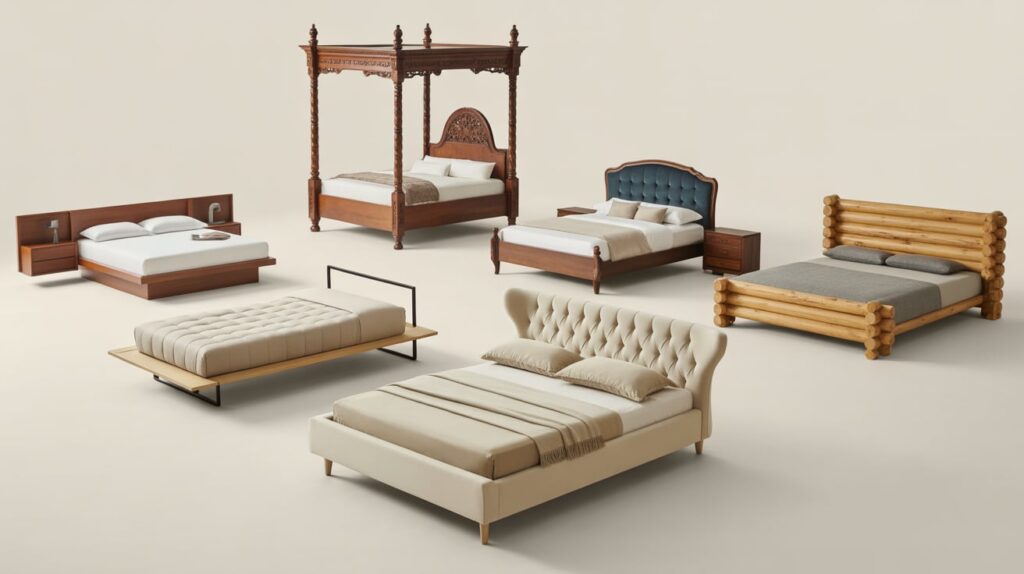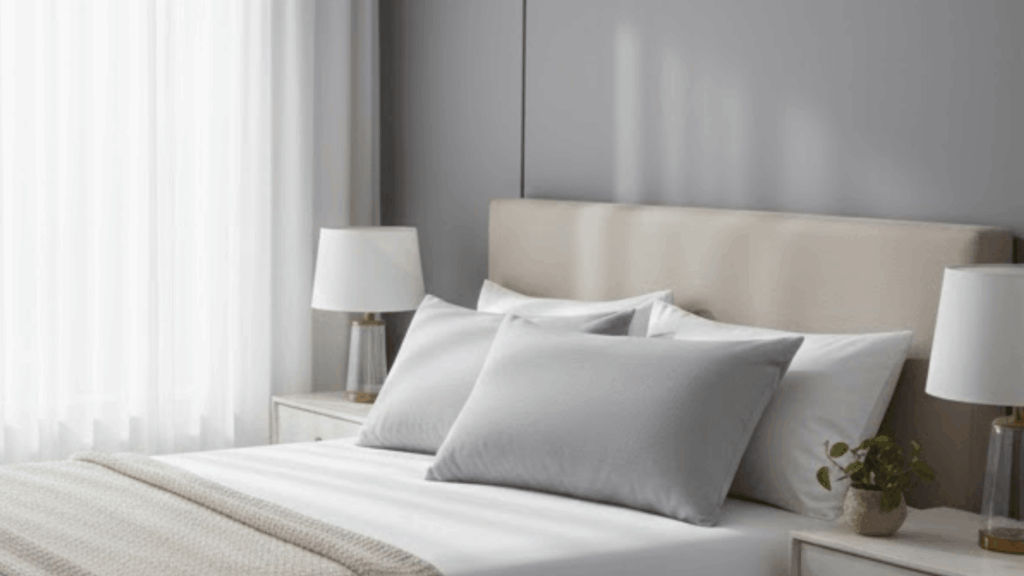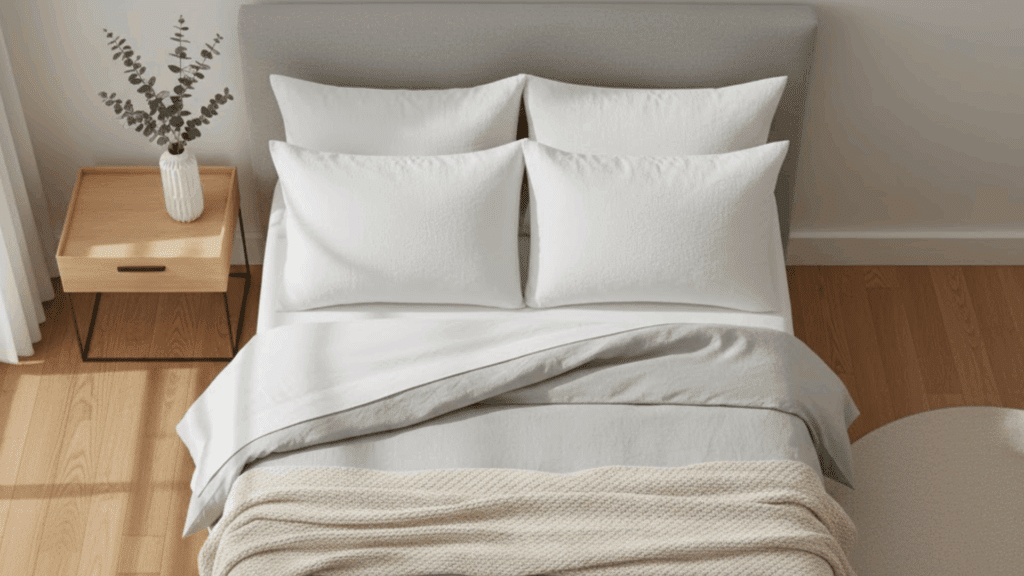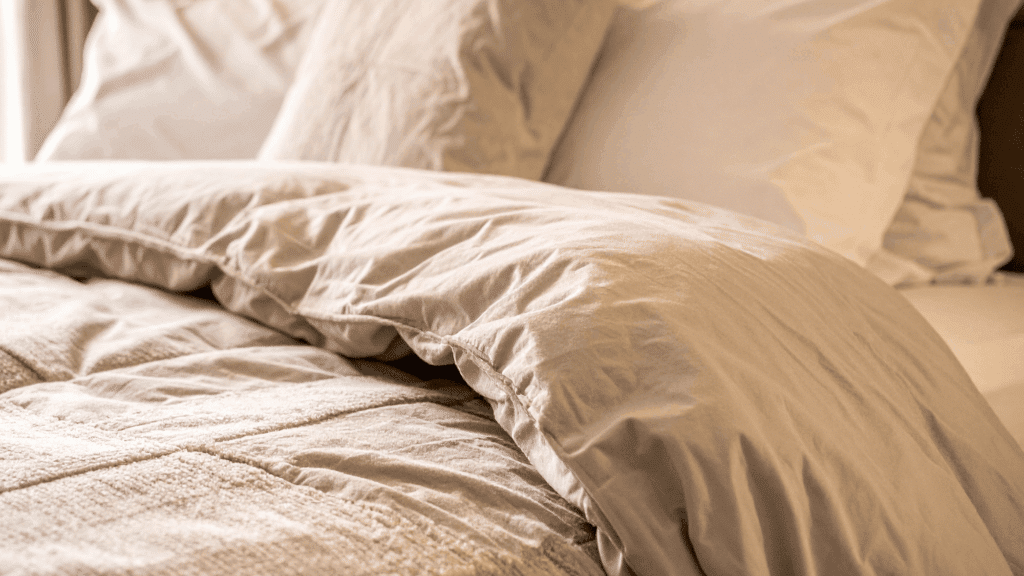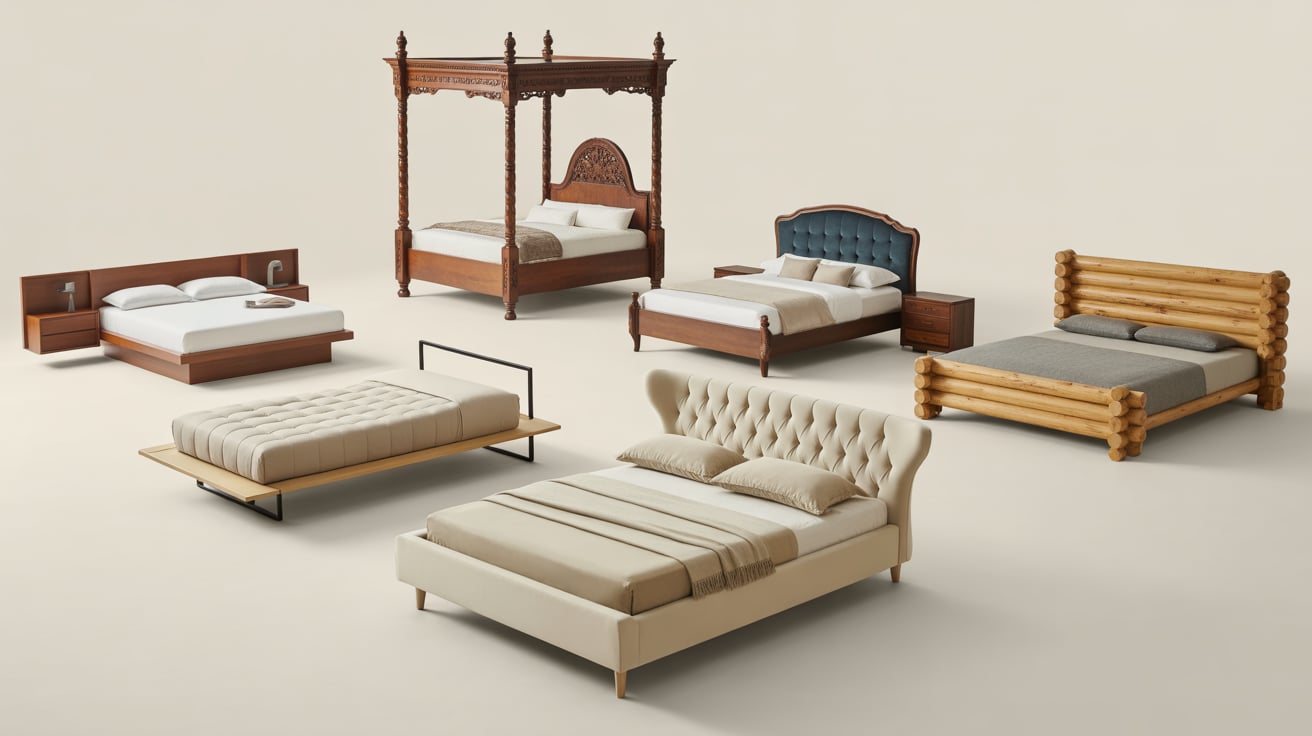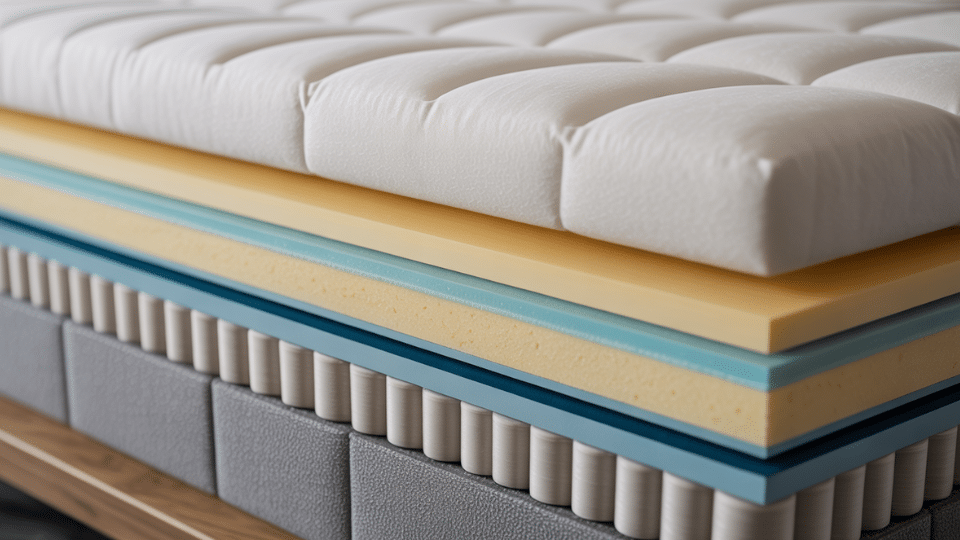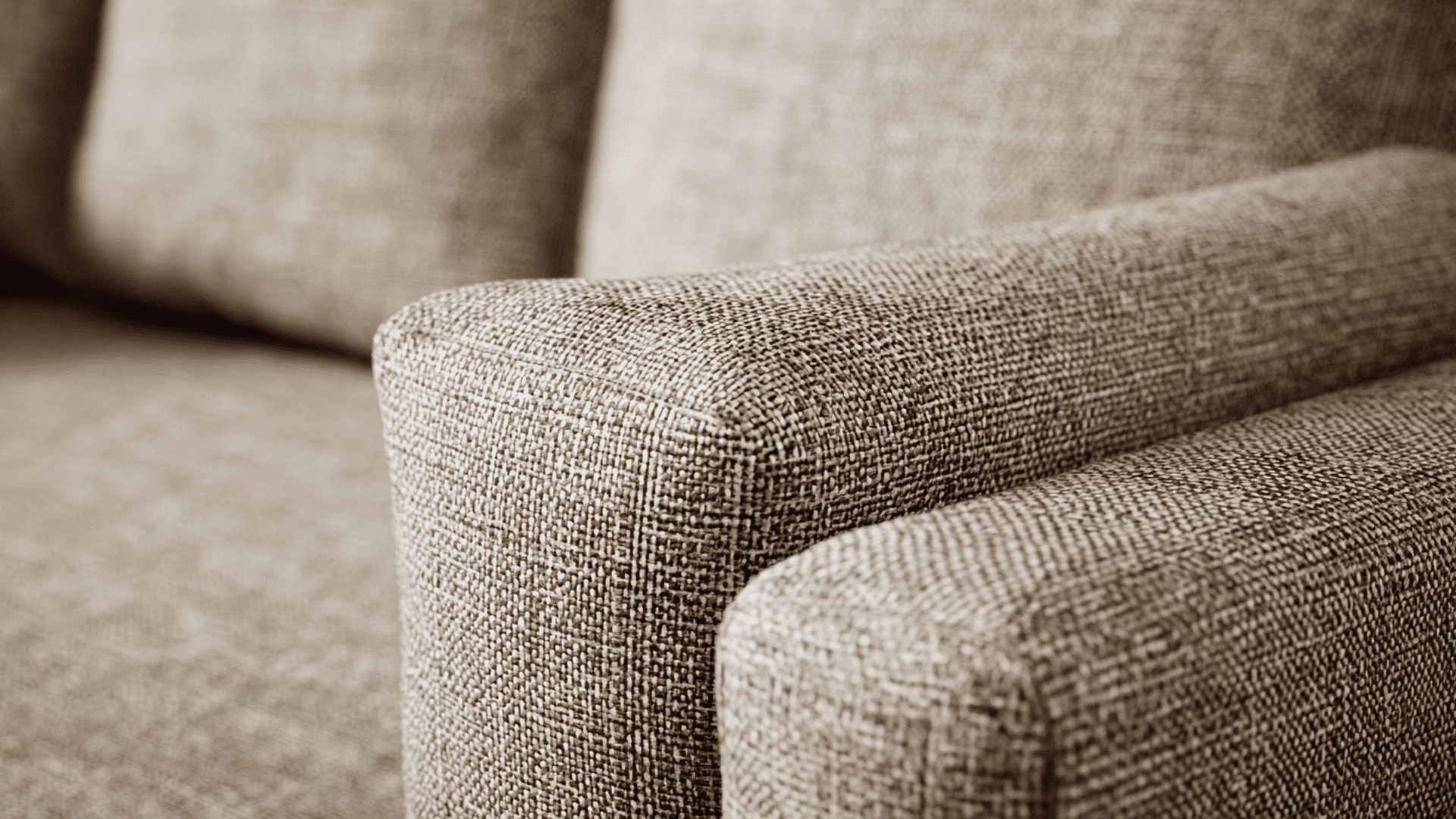I still remember standing in a showroom, staring at row after row of frames, feeling unsure about all the types of beds.
I just wanted something that fit my room, my budget, and how I actually sleep. If you’re in that same place, I get it. It’s easy to feel stuck between size, storage, style, and comfort.
The good news is that once you see the main groups side by side, the choice starts to feel simple rather than stressful.
In this guide, I’ll walk you through clear categories, real-life use cases, and key mistakes to avoid, so you can finally feel confident picking between different types of beds.
Quick Overview: The Main Types of Beds
Here is a simple look at the main bed groups. This quick view helps you compare bed options and understand which group fits your room and routine.
| Category | What It Covers |
|---|---|
| Standard Bed Sizes | Basic mattress sizes are used in many homes |
| Bed Frame Styles | Common frame shapes and designs |
| Storage and Space-Saving Beds | Beds that help with storage or tight rooms |
| Upholstery & Material-Based Beds | Beds built from one main material |
| Adjustable and Tech Beds | Beds that raise, lower, or shift for comfort |
| Cultural Bed Types | Beds shaped by long-used designs in different regions |
| Kids’ and Specialty Beds | Beds made for children or themed setups |
| Luxury and Niche Beds | Less common beds with unique forms |
These groups give you a clear starting point. They make it easier to compare choices and move into deeper details as you find different bed types.
How to Choose the Right Type of Bed
Use these steps to pick a bed that fits your room, supports your sleep needs, and feels easy to live with every day.
1. Choose the right mattress size: Pick a size that fits your room and the number of sleepers. A larger size gives more room to move, but make sure you leave walking space around the bed.
2. Pick a bed design: Choose a design based on how you use your room. For example, storage beds help with tight rooms, while simple frames work well in open spaces.
3. Decide ideal bed height: Think about how easy it is to sit down and stand up. Higher beds help people with stiff joints. Lower beds work better for younger sleepers and small rooms.
4. Choose frame material: Wood feels warm and steady. Metal is strong and easy to clean. Upholstered frames add softness for sitting up. Pick what fits your comfort level and care needs.
5. Match the style to your room: Look at the colors, furniture, and layout in your room. Pick a bed that fits the overall look so the space feels simple and put together.
Bed Types You Probably Didn’t Know Existed
These bed sizes help you plan your room, choose proper spacing, and pick the right fit for single sleepers, couples, and families.
1. Twin Bed
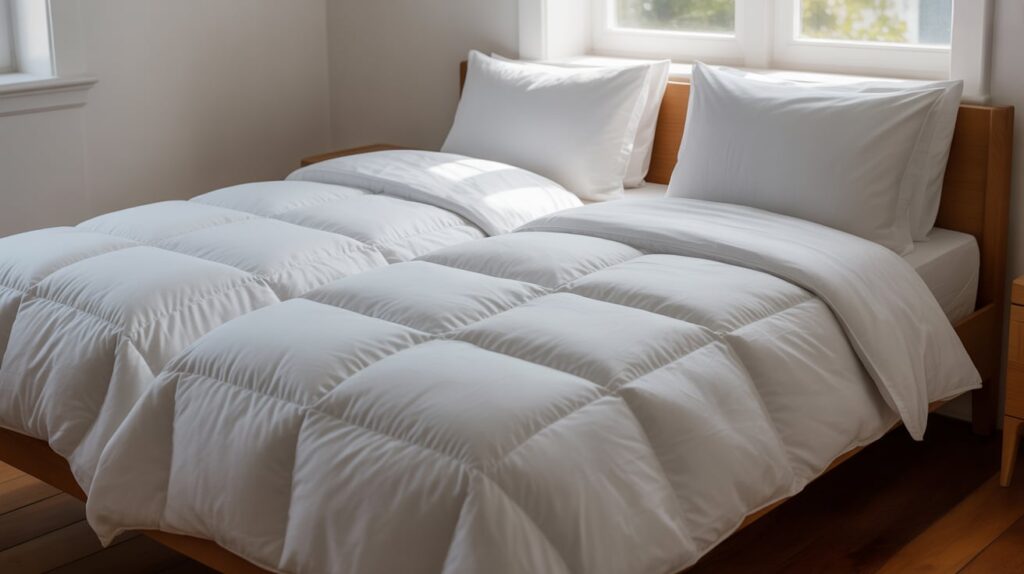
A twin bed is a steady choice for kids, teens, or single adults in tight rooms. It fits small spaces without crowding the layout. You can use it in guest rooms, bunk setups, or rooms with limited walking space.
The size supports one sleeper with enough room to rest, turn, and stretch. It also works well with simple frames, storage frames, or metal bases. Many homes use twin beds for flexible sleeping plans.
2. Twin XL Bed
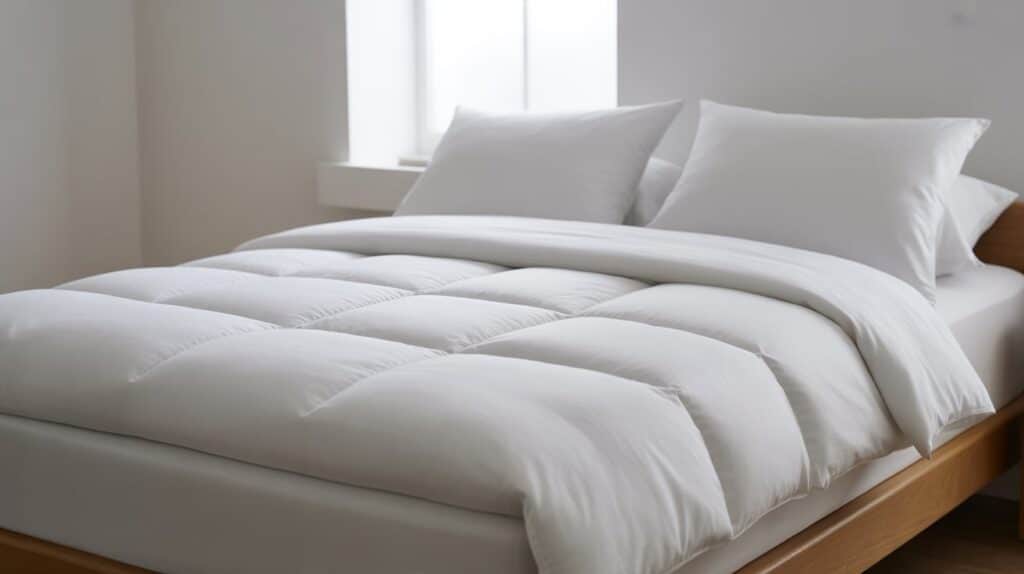
A twin XL bed adds length for taller sleepers who need extra leg room. It is common in dorm rooms, studio units, or guest rooms where floor space is limited but comfort still matters.
The longer design works well for teens, college students, and adults who prefer a narrow setup with added stretch room. Many people choose twin XL frames when they want easy movement, simple bedding needs, and a size that fits many room shapes.
3. Full Bed
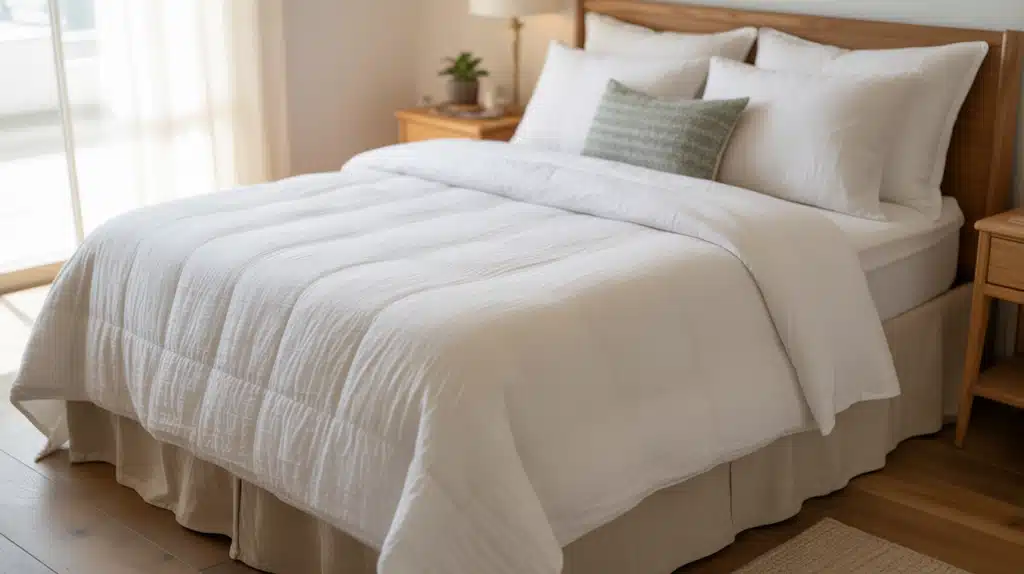
A full bed is wider than a twin and gives one adult extra room to move. It also works for two kids who share a bed. Many guest rooms use a full-size bed because it fits well in medium rooms without blocking walking paths.
This size also supports basic frames, storage frames, or upholstered designs. It helps sleepers who turn often or want more personal space. A full bed balances comfort, space, and room layout needs.
4. Queen Bed
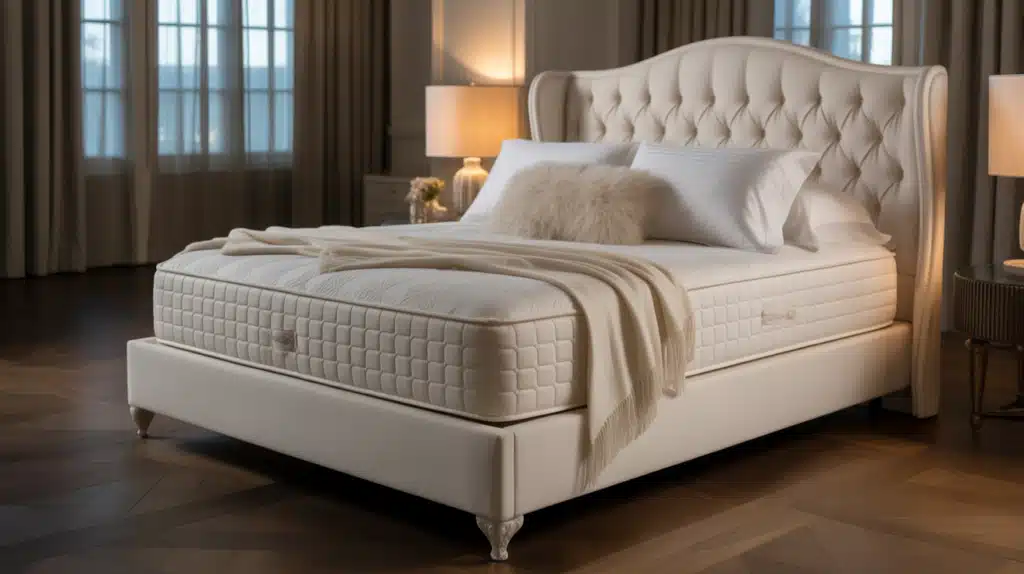
A queen bed is a common pick for couples or single adults who want more width. It fits well in primary bedrooms or medium-sized rooms with simple layouts.
A queen offers enough room for stretching, shifting positions, and staying comfortable through the night.
It works with many frame options, including platform frames, storage frames, and upholstered frames. This size supports a wide range of sleepers and bedding choices, making it useful for many homes.
5. King Bed

A king bed gives two adults plenty of space to rest without crowding each other. It fits well in large rooms with open layouts and wide walking paths. Couples with pets or young children often prefer this size for added room at night.
A king works with sturdy frames that support the extra width. It also allows comfortable movement during sleep, making it a steady pick for people who shift often or need more breathing room.
6. California King Bed
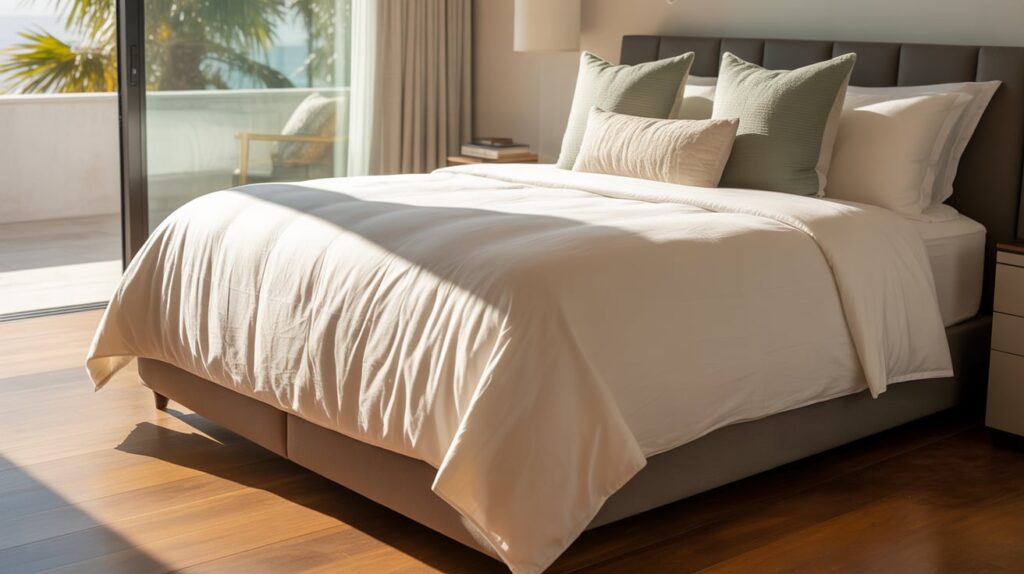
A California king is longer and slightly narrower than a standard king. Tall sleepers benefit from the extra length, especially those with long legs. It works well in long rooms or rooms with narrow layouts.
This size fits two adults comfortably and still leaves space for movement at the edges. Many people choose a California king when height comfort is a priority. It pairs well with strong frames that support the added length and weight.
7. Split King Bed

A split king uses two twin XL bases placed side by side. Each side moves or supports weight separately, helping couples with different sleep needs. This setup works well with adjustable bases that raise or lower each half.
Split king beds help reduce motion between sleepers and make mattress changes easier. The design also helps people with special comfort needs on one side. Many homes use this size for flexible comfort and simple movement.
8. Olympic Queen Bed
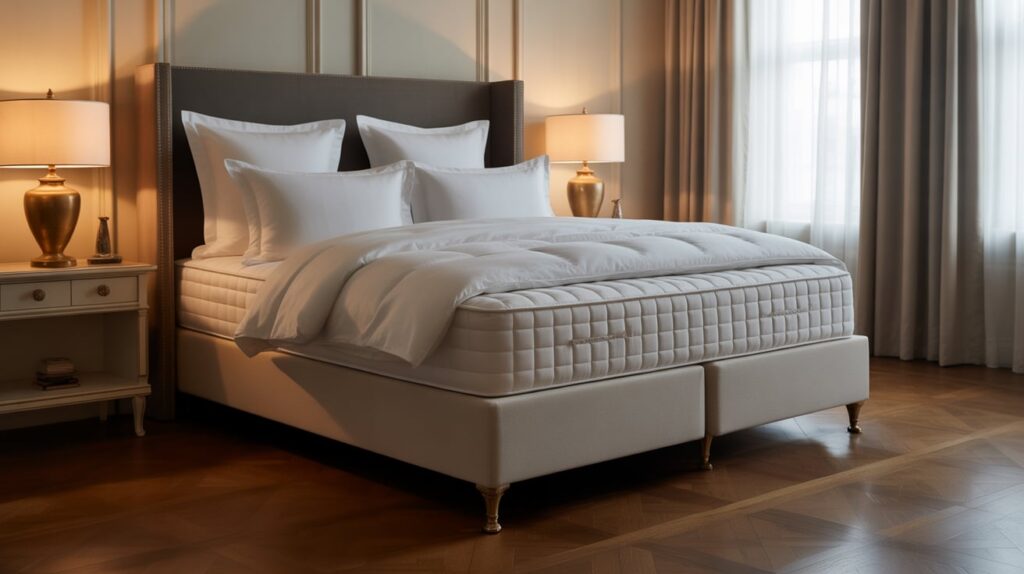
An Olympic queen adds extra width compared to a standard queen. It gives couples more room without reaching king size. This size works well in medium to large rooms that can handle the added width.
The extra space helps sleepers move freely while still keeping the room open. Many choose an Olympic queen when they want more comfort but prefer a frame smaller than a full king. It supports various frames and bedding types easily.
9. Texas King Bed
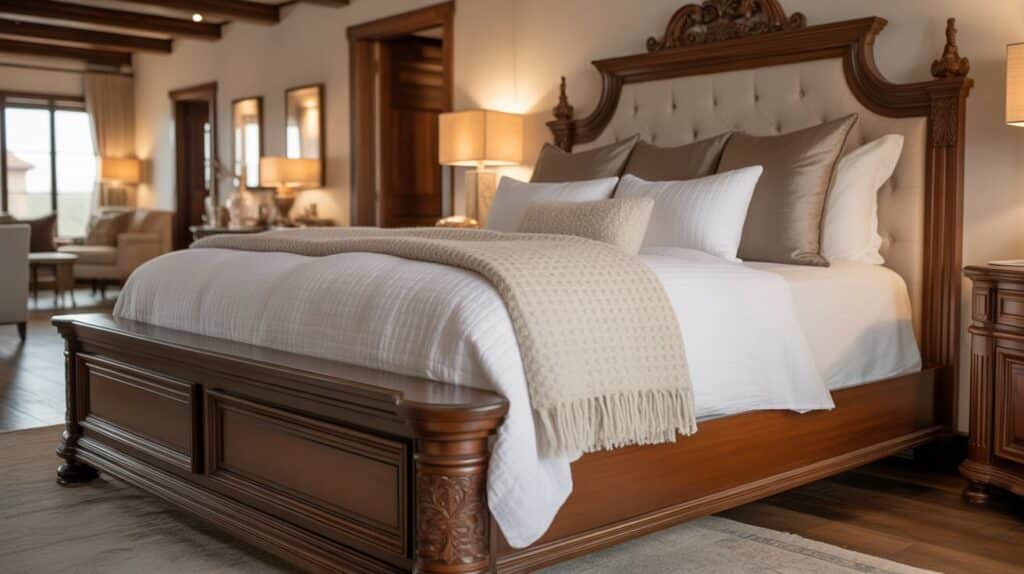
A Texas king is wider and longer than most standard large beds. It offers generous room for couples, children, and pets who share the bed. This size works best in spacious rooms with open layouts.
People often pick this option for wide homes, open master suites, or rooms where comfort is the main focus. The size needs a strong frame that can handle weight and movement. It provides a roomy resting area for relaxed sleep.
10. Wyoming King Bed
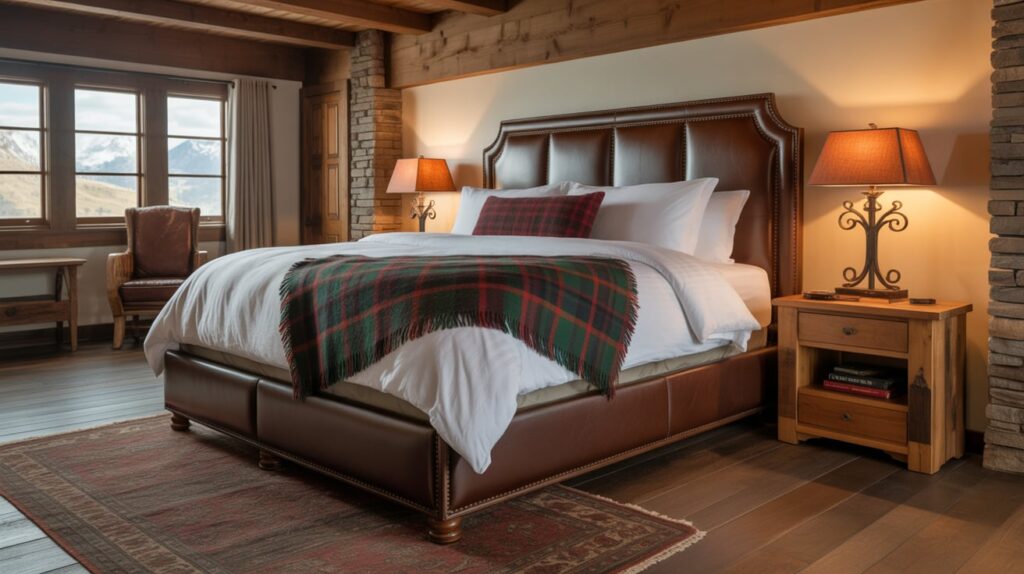
A Wyoming king is large and square-shaped, offering wide sleep space in every direction. It fits well in very large rooms with even layouts and wide walking areas. Families who co-sleep often prefer this size because it supports multiple sleepers comfortably.
The wide shape helps with movement, stretching, and rest. The frame must be sturdy and placed in a room with enough open space. It creates a broad resting area for steady nightly comfort.
11. Alaskan King Bed
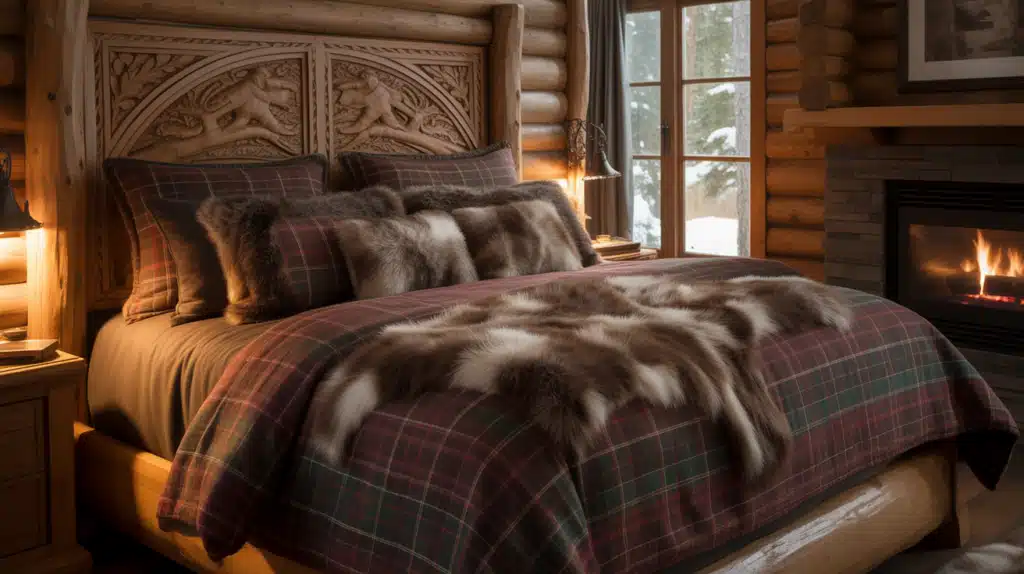
An Alaskan king is one of the largest beds available, offering major room for families or multiple sleepers. It fits only in very large bedrooms due to its width and length. People choose this size when they want a large resting space with no crowding.
Pets, children, and adults can sleep together comfortably. The frame must be strong and steady. It is often used in large homes where space supports comfort, movement, and calm sleep.
Bed Frame Styles
These frame styles shape how your bed looks and feels. Each one supports different room layouts, comfort needs, and everyday habits.
12. Platform Bed
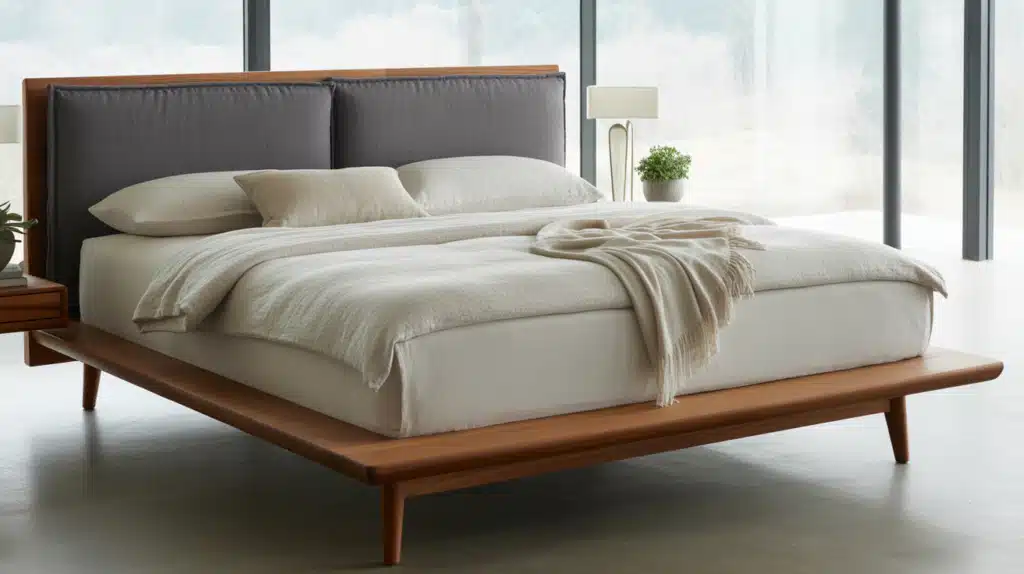
A platform bed uses a solid base or slats to hold the mattress without a box spring. It sits low, feels steady, and keeps the setup simple. Many people choose it for small rooms because the low height avoids crowding.
It supports foam, hybrid, and spring mattresses with ease. You can find wood, metal, or upholstered versions, giving you many options for different room plans. It works well for sleepers who prefer a firm surface.
13. Panel Bed
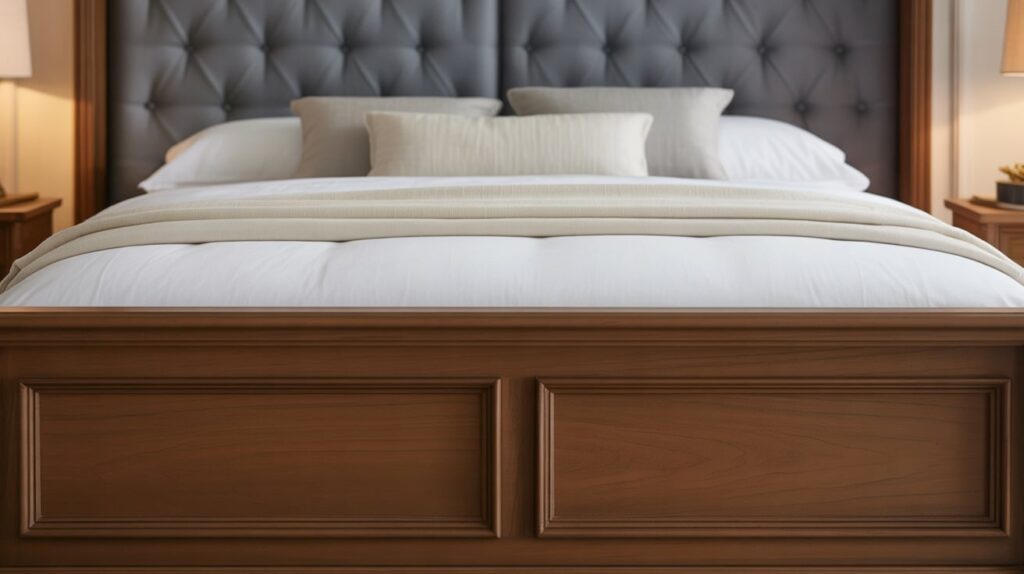
A panel bed uses a headboard and footboard made from wood panels or slatted designs. It usually works with a box spring, which adds height and comfort. The design fits many rooms, from small guest rooms to larger primary spaces.
You can find light or dark wood depending on your furniture. Panel beds also fit well with storage units underneath if the frame height allows it. This style stays steady, strong, and practical for long-term use.
14. Sleigh Bed
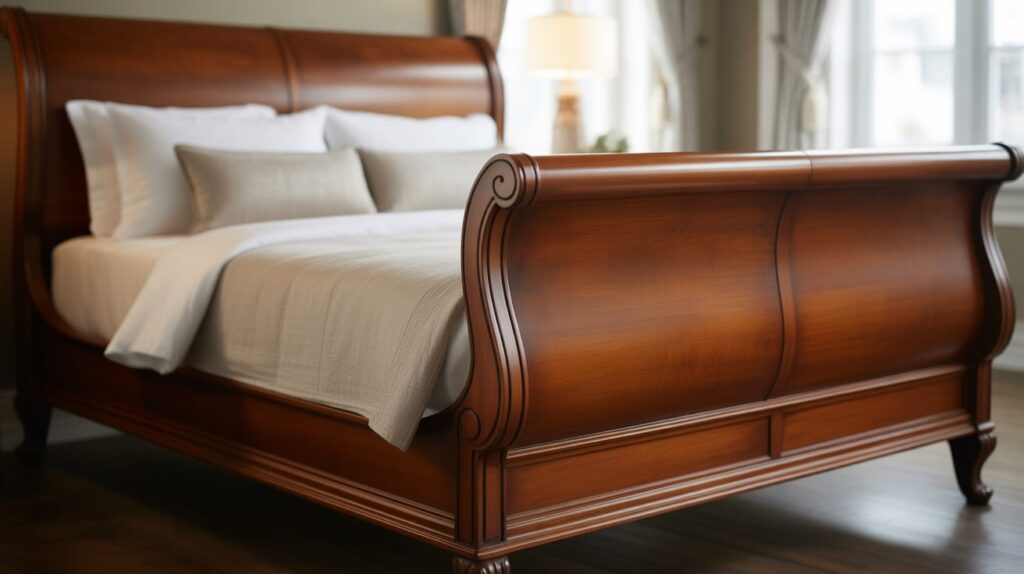
A sleigh bed has curved edges on the headboard and footboard, giving it a bold, sturdy shape. It often uses wood with smooth lines and a strong frame. Because the ends curve outward, the bed takes more space, so it works best in medium or large rooms.
Many people pick sleigh beds for a warm, grounded look. The frame supports a box spring and mattress easily. It is dependable and comfortable, working well for relaxed rest.
15. Canopy Bed

A canopy bed has four tall posts connected at the top, forming an open frame. You can keep the frame clear or add simple fabric panels for privacy. This bed fits best in rooms with higher ceilings, so the posts do not feel cramped.
The shape brings height and presence to the room. It works with wood or metal frames and supports different mattress types. Many people enjoy the cozy feel created by the surrounding frame.
16. Four-Poster Bed

A four-poster bed has tall posts at each corner without a connecting top frame. The posts give the bed a structured shape that stands out without feeling heavy. This style fits medium or large rooms where the posts have space to rise freely.
You can choose slender or thick posts based on your room layout. The bed works with wood or metal frames and supports many mattress setups. It offers height without adding extra overhead structure.
17. Low-Profile Bed

A low-profile bed sits close to the ground, creating an open feel in smaller rooms. It uses a short frame that keeps the mattress at a comfortable height for younger sleepers or those who prefer a simple step-in setup.
Many designs pair well with platform bases, so you may not need a box spring. The shorter look helps rooms feel wider and more open. It works well in tight spaces or modern layouts that favor clean lines.
18. Floating Bed

A floating bed uses hidden supports or a recessed base to create the look of a bed hovering above the floor. It opens up tight rooms by keeping the lower area clear. Many people choose floating frames to reduce visual weight and keep the room simple.
The base must be strong to hold the mattress properly. LED strips or soft lighting are sometimes added under the frame, but this is optional. Floating beds work well in clean, open layouts.
19. Mission-Style Bed

A mission-style bed uses straight lines, thick wood, and simple slats to form a solid frame. The design focuses on durability and straightforward structure.
The headboard often includes vertical or horizontal slats that add gentle texture without extra detail. This bed fits well in rooms with wood furniture or simple decor.
It feels steady and supportive, making it a practical long-term choice. Mission frames work with many mattress types, creating a strong base for sleep.
20. Shaker Bed
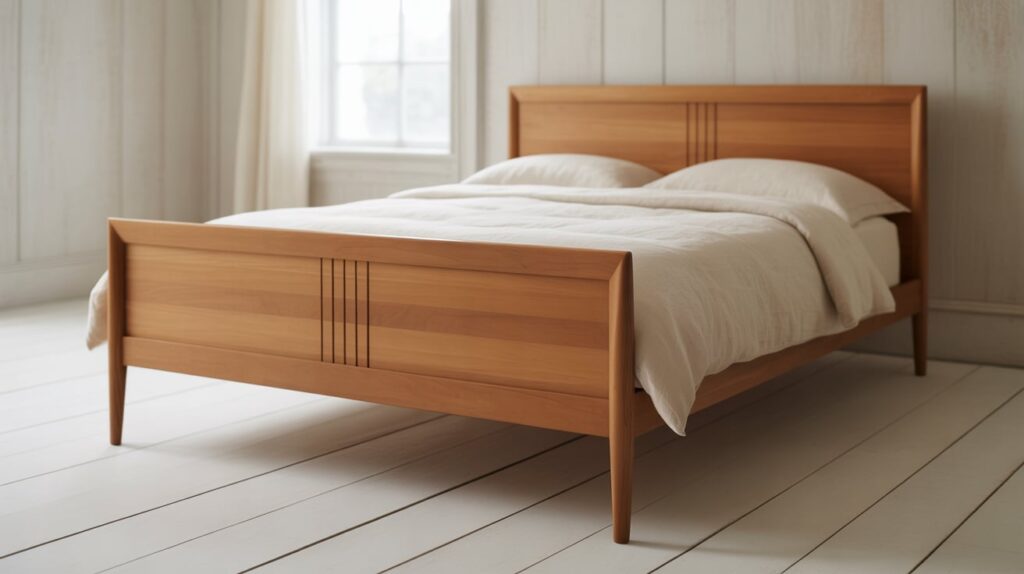
A shaker bed features clean lines, smooth wood, and a modest frame. The headboard is usually flat or slightly curved, keeping the design plain and practical. This style works well in small and medium rooms because it does not crowd the space.
Shaker beds pair well with natural wood tones and simple furniture. The frame stays strong over time and gives reliable support for many mattress types. Its easy shape fits a wide range of room layouts.
21. Spindle Bed
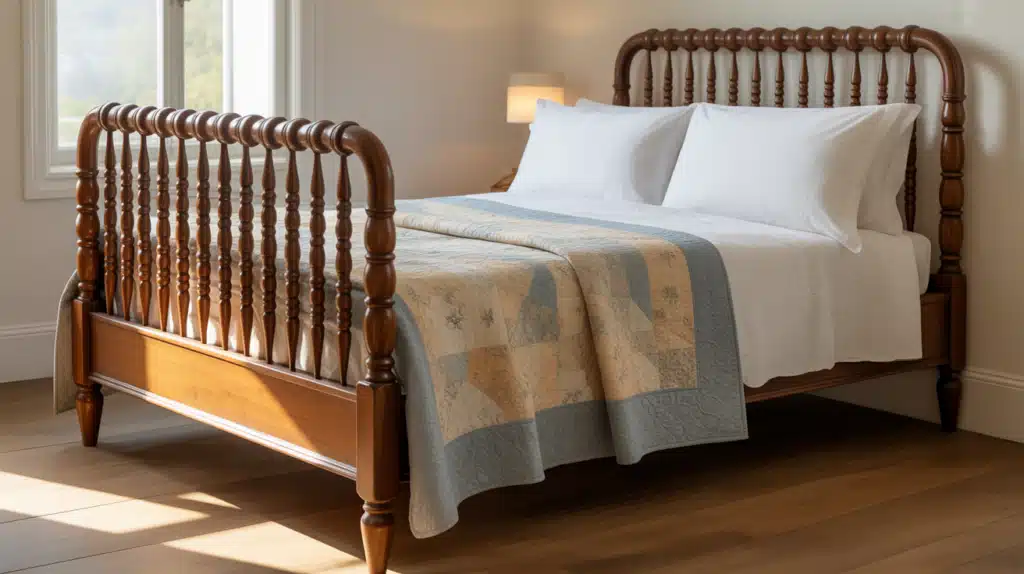
A spindle bed has rows of thin wooden or metal rods on the headboard and sometimes the footboard. The open spaces between the spindles keep the bed light and airy. This design works well in small rooms because it allows more visual flow.
Spindle frames fit many home styles and pair well with simple bedding. The structure stays steady while keeping the look open. Many people choose it for a calm, uncluttered bedroom setup.
22. Wingback Bed
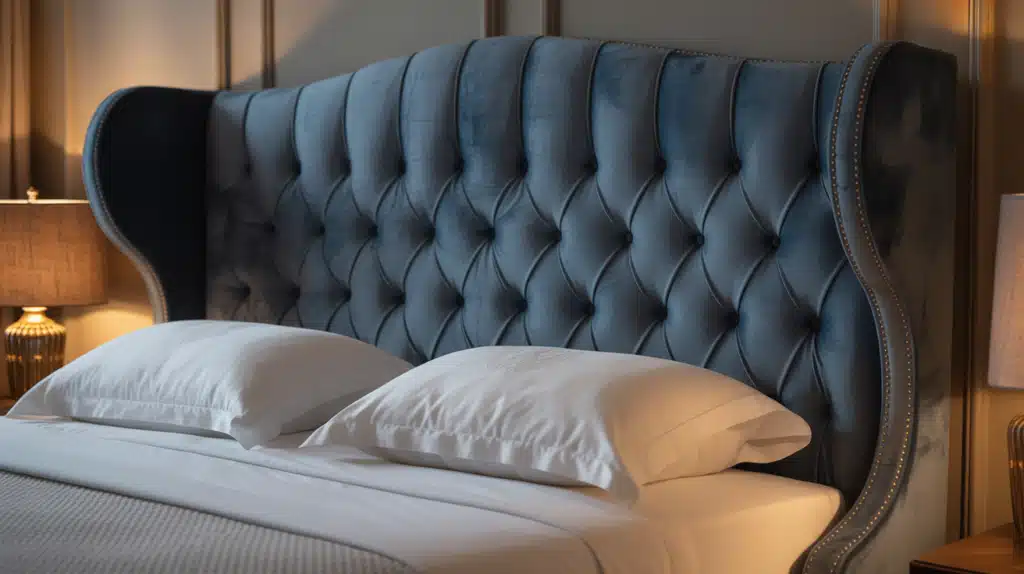
A wingback bed features a tall headboard with side panels that angle outward to form soft “wings.” These wings offer support for sitting upright and help create a cozy resting space.
Many wingback frames use padded or fabric-covered surfaces, giving comfort without extra bulk. The design works well in medium and large rooms where the tall headboard has room to stand out. It also pairs well with simple or warm bedding choices.
23. Slat Bed

A slat bed uses evenly spaced wooden slats as the base for the mattress. The slats help with airflow and support by keeping the mattress steady. This bed works well with foam or hybrid mattresses, though spacing must be close enough to prevent sagging.
Slat frames come in many shapes, from simple wood frames to more detailed headboards. They offer a solid balance of support and comfort. Many people choose slat beds for long-term, stable use.
Storage & Function-Focused Beds
These beds help you save space, stay organized, and support daily needs. Each option works well in tight rooms or busy homes with limited storage.
24. Storage Bed
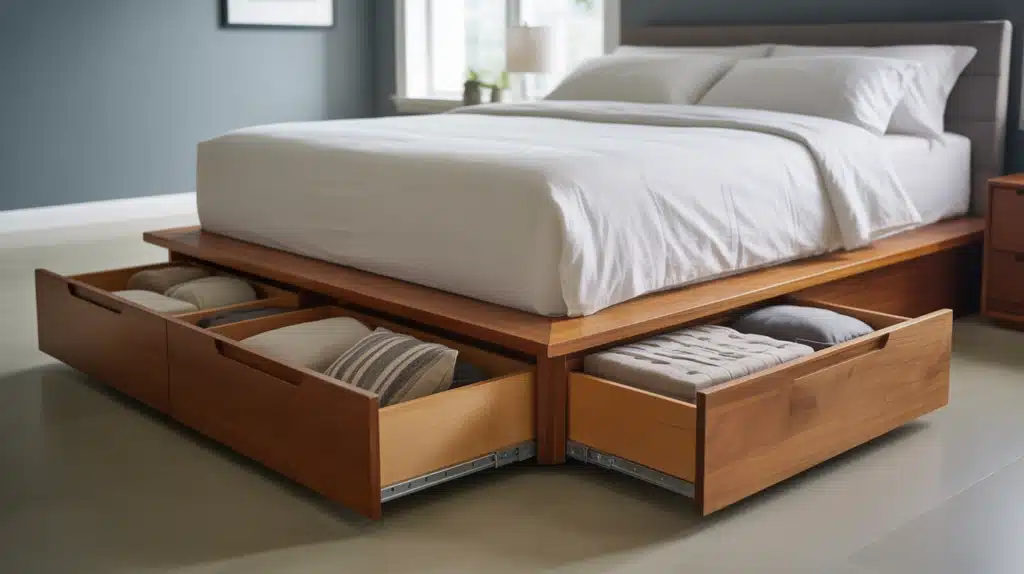
A storage bed includes built-in areas under the mattress for keeping clothes, blankets, or spare items. It helps small rooms stay tidy without needing more furniture. Drawers or lift-up bases give easy access to stored items.
Many frames work with wood, fabric, or metal designs. This bed is useful for people who want order without filling the room with extra units. The steady frame supports regular mattresses while adding helpful space beneath the main surface.
25. Captain’s Bed

A captain’s bed blends sleeping space with built-in drawers and often a headboard shelf. It is ideal for rooms with limited floor space. The side drawers help store clothing, bedding, or small items. Some versions include a trundle for extra sleeping room.
The design fits well in kids’ rooms, guest rooms, or compact layouts. It keeps items within reach while keeping the room calm and organized. The frame stays strong and dependable for daily use.
26. Ottoman Bed
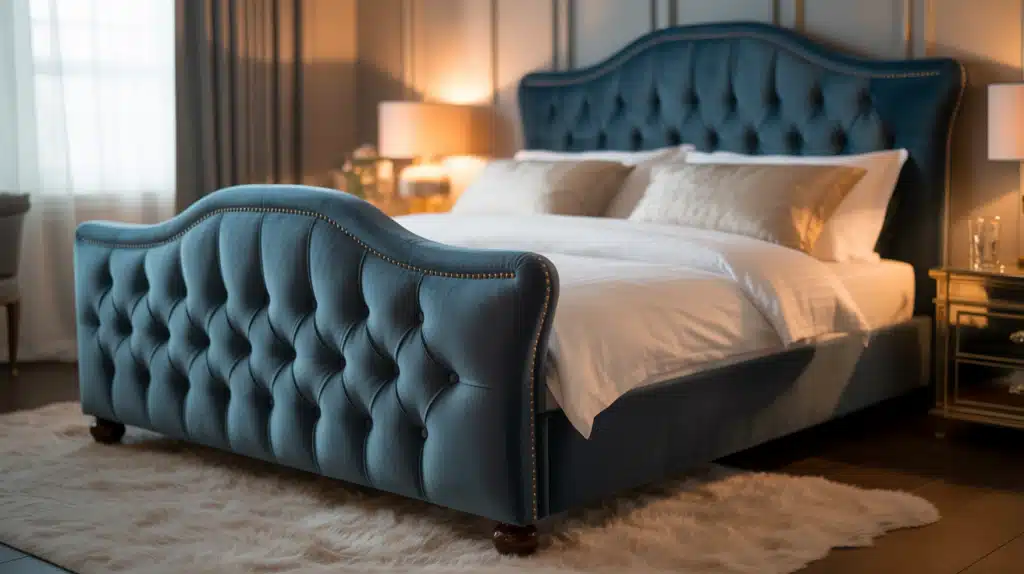
An ottoman bed lifts from the top to reveal a roomy hidden area beneath the mattress. The lift system gives easy access without sliding drawers. This bed works well when side space is limited.
People use it for seasonal bedding, extra pillows, or items they do not need often. The base must be strong enough to hold the mattress during lifting. It helps create a cleaner room by giving a wide area for storing bulkier items.
27. Bookcase Bed
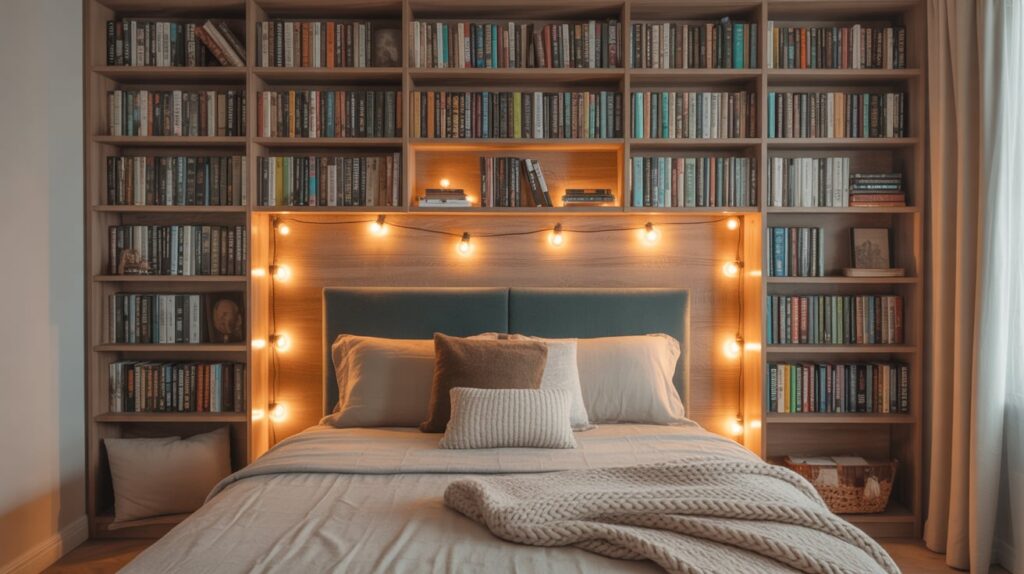
A bookcase bed has shelves built into the headboard. These shelves hold books, clocks, chargers, or small items you want close by. It helps you avoid extra bedside tables in tight rooms.
Many designs include small drawers or open shelves for simple organization. The structure keeps items easy to reach without clutter. The frame supports most mattress types and works well for kids, teens, or adults who like to keep daily items in one place.
28. Lift-Up Storage Bed

A lift-up storage bed raises the mattress from one end to reveal a deep storage space underneath. The lift feature works smoothly with the help of built-in support arms. It’s useful in rooms where drawer space is limited.
The open area holds larger items like blankets, luggage, or boxes. This choice works well for people who want clear floor space with hidden storage. The frame stays steady and holds the mattress safely while open or closed.
29. Drawer Bed

A drawer bed includes pull-out drawers along the sides or bottom of the frame. These drawers help store clothing, sheets, toys, or shoes. It’s a helpful option for smaller rooms that need extra organization.
The drawers slide out easily if there is clear side space. People choose drawer beds to keep items sorted without adding bulky cabinets. The frame stays firm and supports most mattresses, making it useful for long-term comfort and simple bedroom planning.
30. Trundle Bed

A trundle bed includes a second mattress stored beneath the main frame. You can pull it out when needed for guests or sleepovers. It fits well in kids’ rooms, guest rooms, and small apartments.
The lower bed rolls out smoothly and stores away when not in use. This setup saves floor space while still giving extra sleeping room. It works with many frame styles and helps create a tidy layout that handles visitors with ease.
31. Daybed
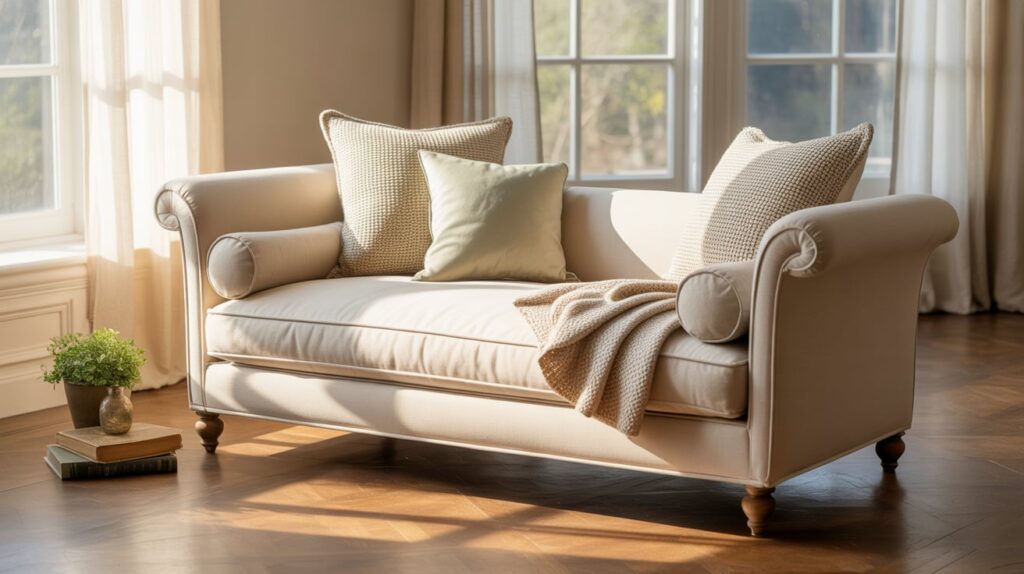
A daybed serves as both a seat and a sleeping space. It works well in guest rooms, small apartments, or home offices that need flexible uses. Some daybeds include storage drawers or a trundle underneath.
The frame supports a twin mattress and allows comfortable resting during the day or night. It blends seating and sleeping needs without taking up extra room.
Many people choose daybeds for tight layouts where they need one piece to handle multiple daily tasks.
32. Murphy Bed
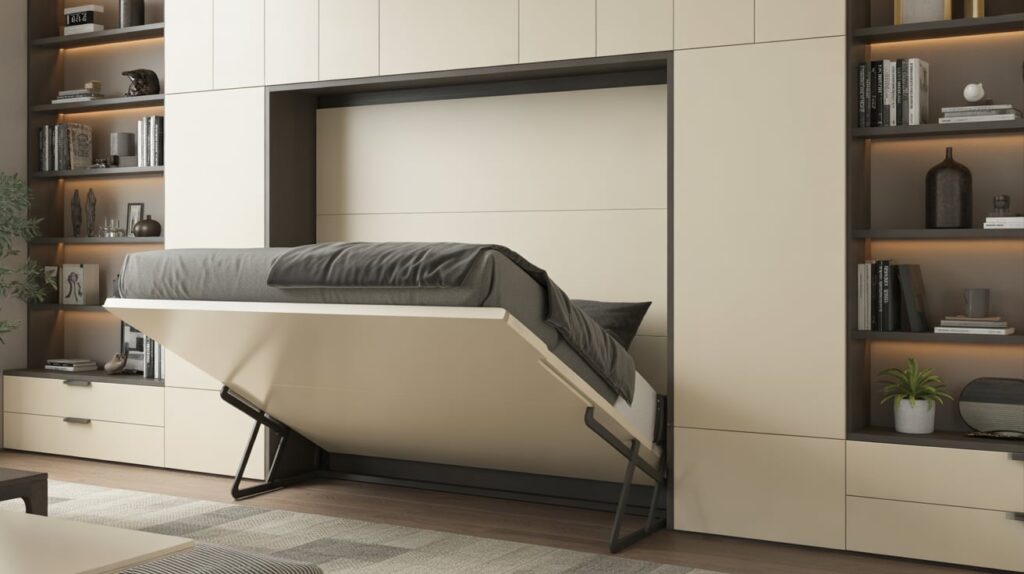
A Murphy bed folds into a wall or cabinet when not in use. It’s helpful in studio apartments, offices, or rooms used for more than one purpose. When folded up, the floor stays open for work or play.
When opened, it offers a full sleeping area. The frame and hinges must be steady for everyday safety. People who want a clean layout with simple switching between tasks often choose a Murphy bed for dependable space control.
33. Loft Bed

A loft bed raises the mattress above the ground to create open space underneath. That lower space holds a desk, seating, or storage units. It’s helpful in kids’ rooms, dorms, and small apartments.
The ladder must be steady, and the top area should have enough guard rails. Loft beds help free valuable floor space for study areas or daily tasks. This setup works for sleepers who enjoy a higher resting area while keeping the room tidy.
34. Bunk Bed
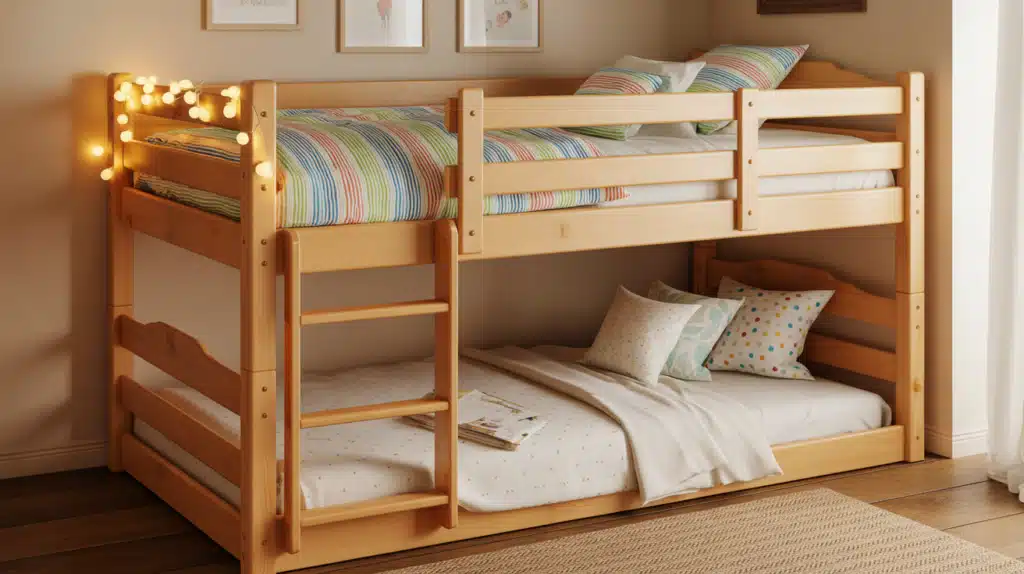
A bunk bed stacks two beds vertically to save floor space. It’s widely used in shared kids’ rooms, dorms, or guest spaces.
The ladder and guard rails must be sturdy for safety. This setup works well when two sleepers need separate resting spaces without taking extra room.
Bunk beds also pair with storage drawers or trundle units in many designs. They support simple organization and daily comfort while keeping the layout clear and functional.
35. Triple Bunk Bed

A triple bunk bed stacks three beds for rooms with multiple sleepers. It works best in tall rooms that give enough headspace for each level. The frame must be very steady and strong to hold all three beds safely.
This setup fits shared kids’ rooms, cabins, or guest areas that host several people at once. Triple bunks help use vertical space wisely and keep the floor open for movement or storage needs.
36. Futon Bed
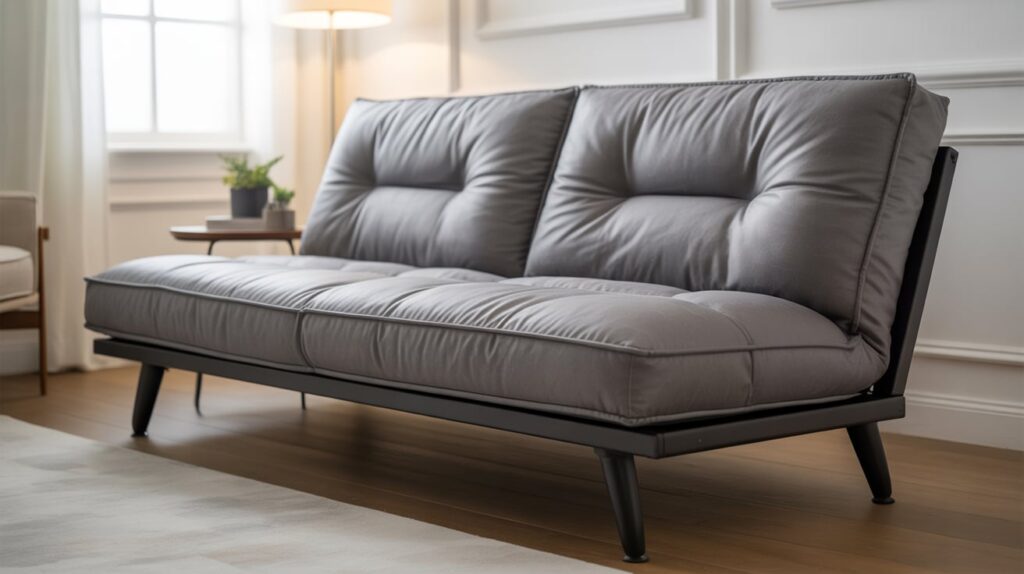
A futon bed folds easily between sitting and sleeping positions. It’s common in small apartments, dorms, and multipurpose rooms. The mattress sits on a frame that flattens for sleep or bends for seating. This design supports flexible living in tight areas.
Many people use futons as daily seating and nighttime beds. The frame must stay firm for both uses, and the mattress should provide steady support. Futons work well for simple, compact living.
37. Convertible Sofa Bed
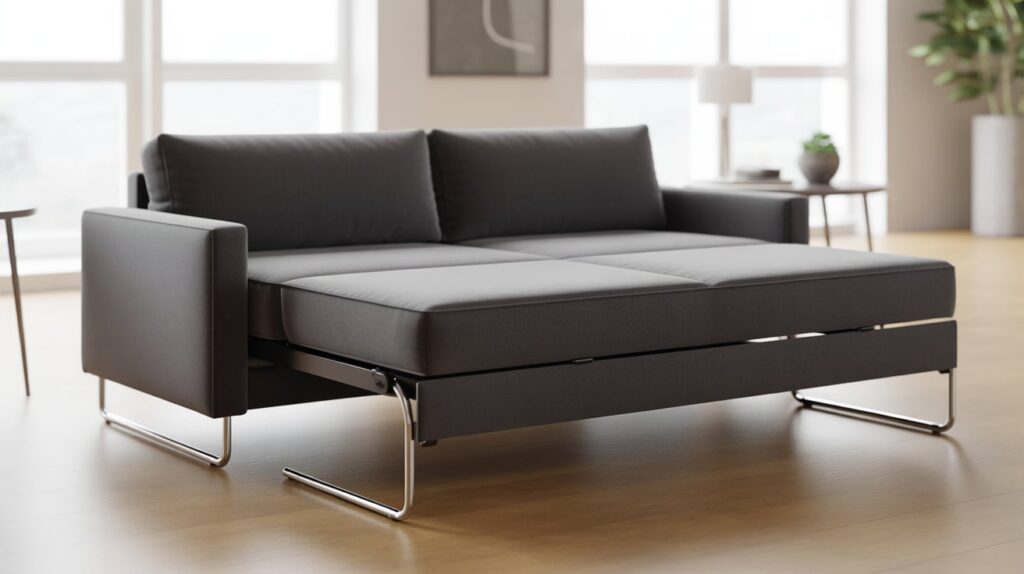
A convertible sofa bed shifts from a couch to a bed with minimal effort. It suits living rooms, studios, or guest spaces that need both seating and sleeping functions.
The mattress may fold out or rest inside the frame. This setup helps you host visitors without keeping a full bed open. It’s popular for homes that need flexible furniture. The frame and cushions must be firm enough for comfortable sitting and dependable sleep.
38. Pull-Out Bed
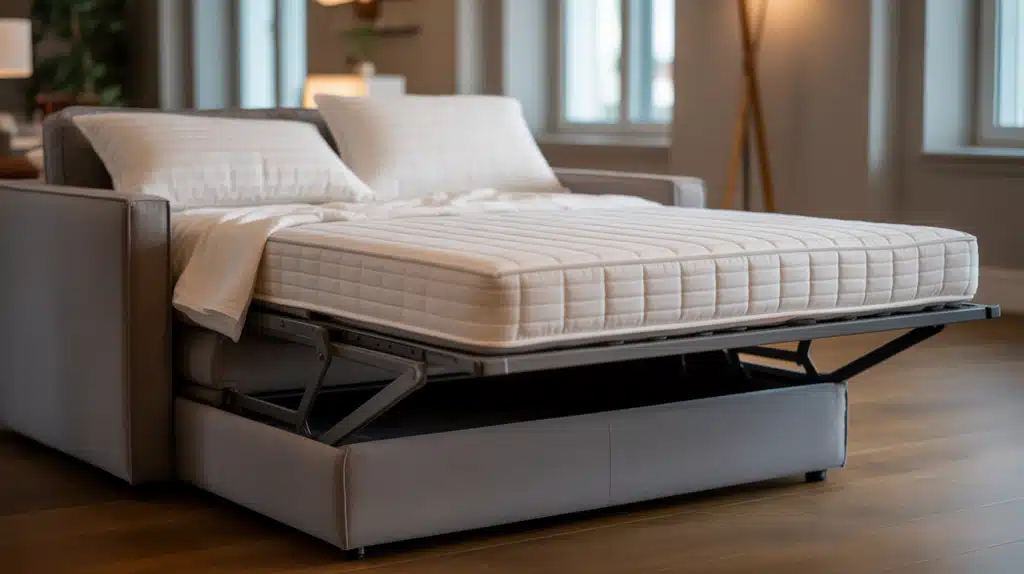
A pull-out bed sits hidden inside a base, drawer, or sofa frame until needed. You slide it outward to create a flat sleeping surface. This option works well in small rooms, guest areas, or playrooms. It saves space while giving extra sleeping room when required.
Pull-out beds must glide smoothly and stay steady once extended. They help you handle visitors without crowding your daily layout and fit a wide range of simple room plans.
39. Rollaway Bed
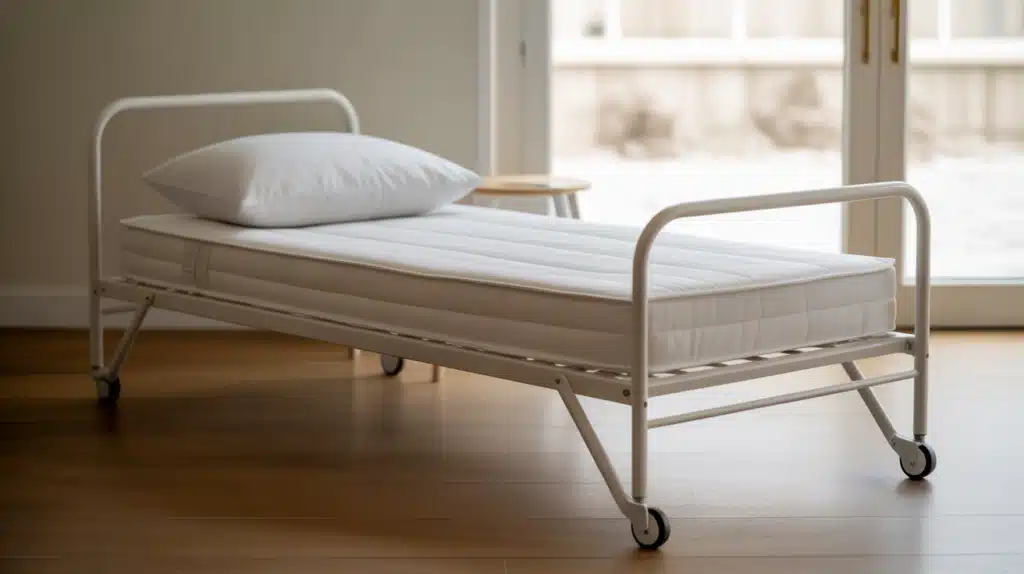
A rollaway bed folds in half and has wheels for easy movement. You can roll it out when needed and store it in a closet when not. It’s useful for visitors and tight bedrooms that lack space for a full bed. The frame must lock firmly when opened.
The mattress is usually thinner, so it works best for short stays. Rollaway beds help homes handle guests without keeping extra beds out in the open.
40. Folding Bed
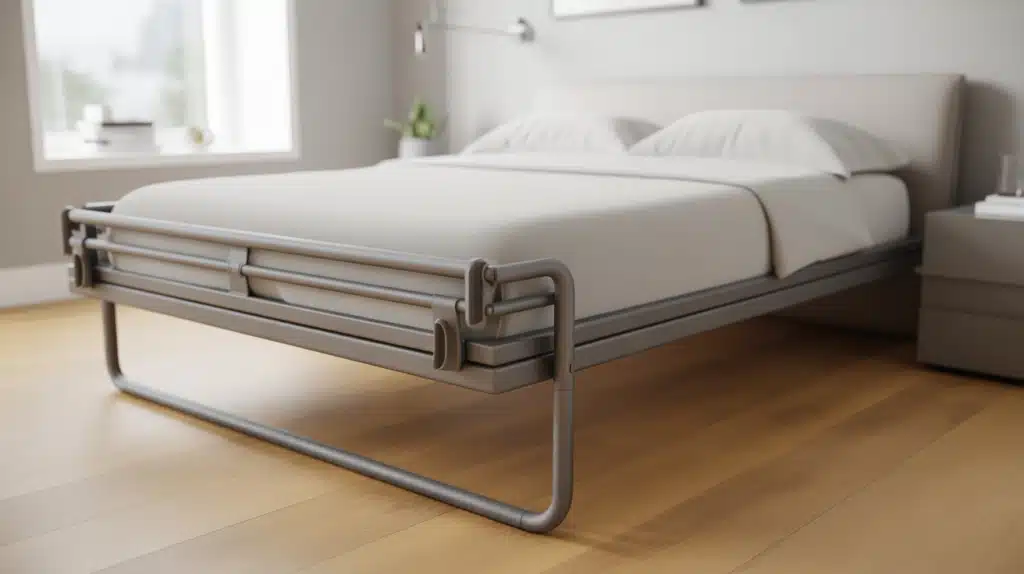
A folding bed bends at the frame and stores away when not in use. It fits closets, garages, or small storage rooms. You unfold it when extra sleeping space is needed. The frame should lock safely and stay steady for short-term rest.
Folding beds are helpful for sudden guests or temporary room setups. They take little space and open in seconds. Many people use them as a quick sleeping option without redesigning the whole room.
41. Recliner Bed

A recliner bed adjusts the back and leg areas to create comfortable resting angles. It works well for people who need support while reading, resting, or recovering from soreness. The powered or manual controls help you find comfortable positions easily.
It fits bedrooms or living rooms that need flexible resting setups. The frame must be strong enough to hold frequent adjustments. This option offers steady comfort for people who prefer raised support during rest.
42. Sofa Sleeper Bed

A sofa sleeper bed holds a fold-out mattress inside a couch frame. It opens into a full sleeping area when guests arrive. During the day, it acts as regular seating. This setup helps small apartments or spare rooms stay open while still offering a place to sleep.
The mattress stores neatly inside the base. Sofa sleepers work well for people who want combined seating and resting needs without using extra space.
43. Guest Cot / Camping Cot

A guest cot or camping cot uses a light frame with a stretched fabric or mesh surface. It folds easily and stores without taking up much space. This option helps with temporary visitors or outdoor use. The frame must stay steady under full weight.
The surface offers simple support for short stays. People use cots when they need quick, portable sleeping setups. They help keep homes ready for guests without using permanent floor space.
Upholstery & Material-Based Beds
These bed frames focus on the main material used. Each option affects strength, feel, care needs, and how the bed fits in your room.
44. Upholstered Bed
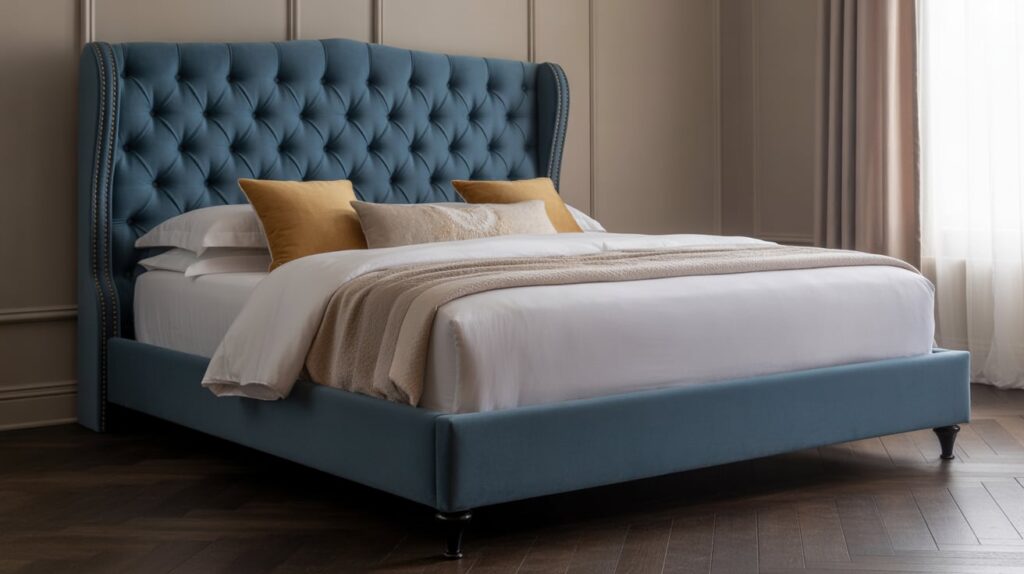
An upholstered bed uses padded fabric around the headboard or full frame. It feels soft when sitting upright and brings a calm look to the room. These beds work well for people who like to read or relax in bed because the cushioned surface offers steady back support.
Upholstered frames come in many colors, patterns, and fabrics. Care is simple with routine cleaning. They fit medium and large rooms where the padded frame has room to stand out.
45. Metal Bed
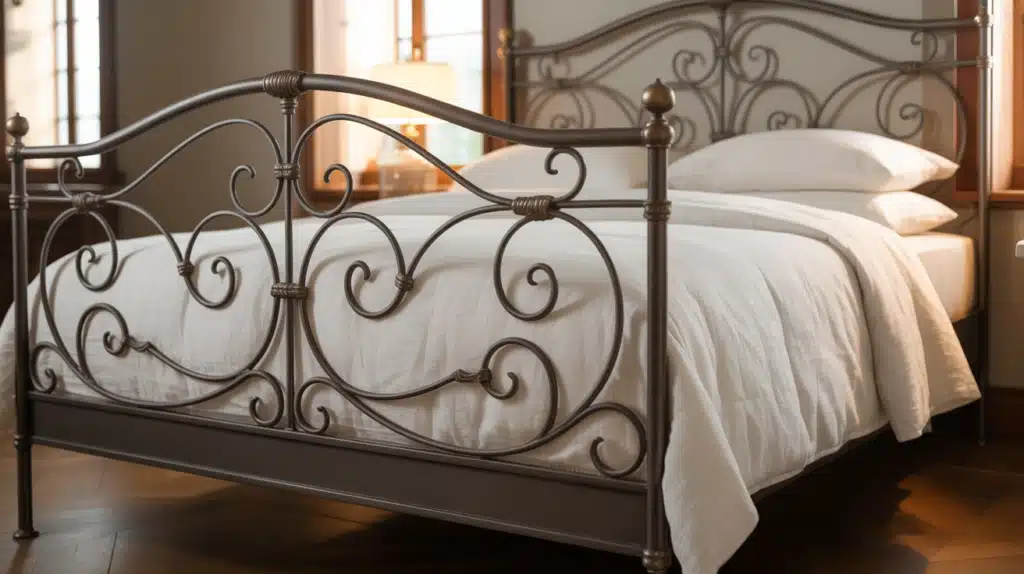
A metal bed uses steel or iron tubes to form a strong, steady frame. It works well in guest rooms, kids’ rooms, or small spaces because the open design keeps the room clear. Metal frames are easy to clean and resist wear over time.
They pair well with many mattress types and stay firm through daily use. Some metal beds include simple headboards, while others offer more shaped designs. They are practical for many different room layouts.
46. Wooden Bed
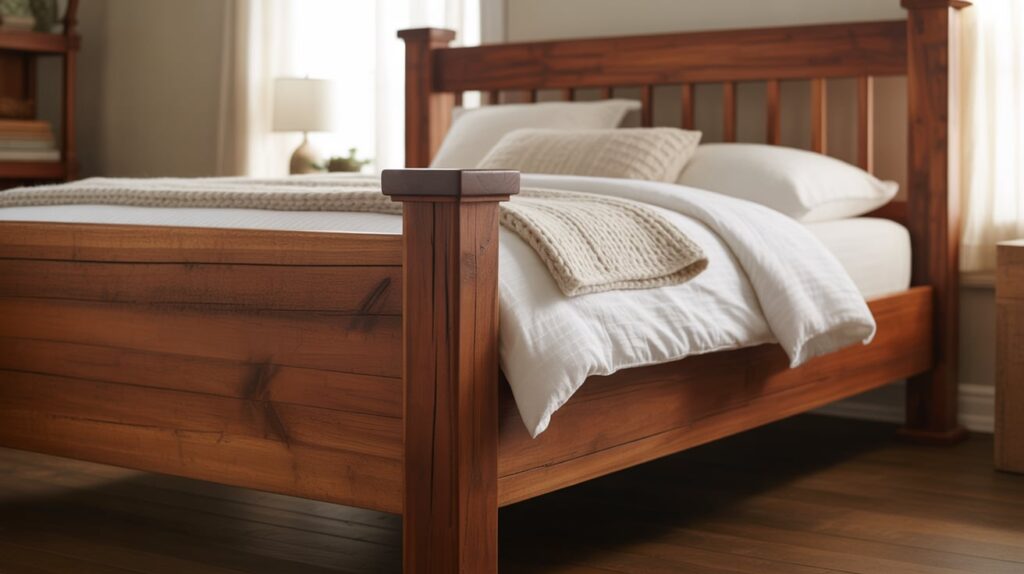
A wooden bed uses solid wood or sturdy panels to form a long-lasting frame. It fits many home styles because wood blends easily with most rooms. These beds range from light to dark tones and come in simple or shaped forms.
Wood frames stay strong and steady for years with basic care. They work well with foam, hybrid, or spring mattresses. Many people choose wood for its warm feel, dependable support, and long-term strength.
47. Wrought Iron Bed

A wrought iron bed uses heavy metal shaped into rods or simple patterns. The frame stays very strong and holds weight well. It works for medium and large rooms because the shape stands tall without blocking airflow.
Wrought iron beds stay firm through daily use and last for many years. They fit many room styles, especially those with wood floors or simple walls. The structure allows good mattress support while keeping the room open and neat.
48. Rattan Bed
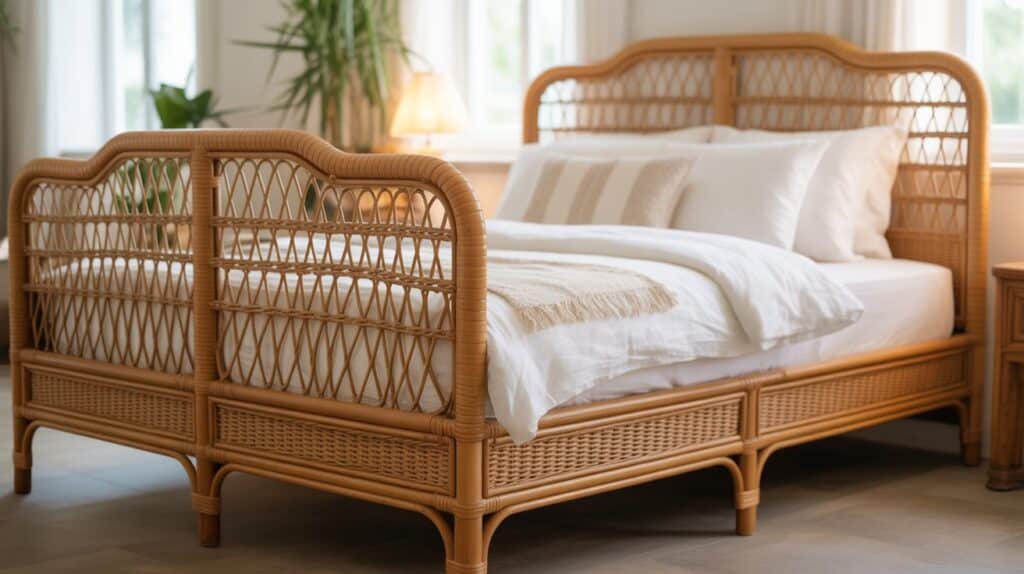
A rattan bed uses woven plant material wrapped around a firm frame. It works well in rooms with natural tones or relaxed setups. The woven surface adds gentle texture without crowding the room.
These beds stay steady when built on a strong wood or metal base. Rattan frames can support most mattress types, though care is needed to keep the woven surface clean. Many people choose rattan for a calm, natural look and light feel.
49. Leather Bed

A leather bed uses real or faux leather stretched over a padded frame. It offers a smooth surface that feels firm yet comfortable when sitting up. Leather beds fit medium and large rooms where their wide panels have room to show.
The material wipes clean easily, which helps busy homes. Many designs use warm tones that blend with wood or metal furniture. The frame stays strong and supports most mattress types without extra parts.
50. Fabric Bed

A fabric bed uses cloth wrapped over padded panels on the headboard or full frame. It adds a soft look and helps create a calm resting area. Fabric beds pair well with simple bedding and work in many rooms, especially those with neutral tones.
Care is simple with basic cleaning. The frame underneath stays strong, supporting foam, hybrid, or spring mattresses. Fabric beds are useful for people who like a soft surface when sitting upright.
51. Bamboo Bed
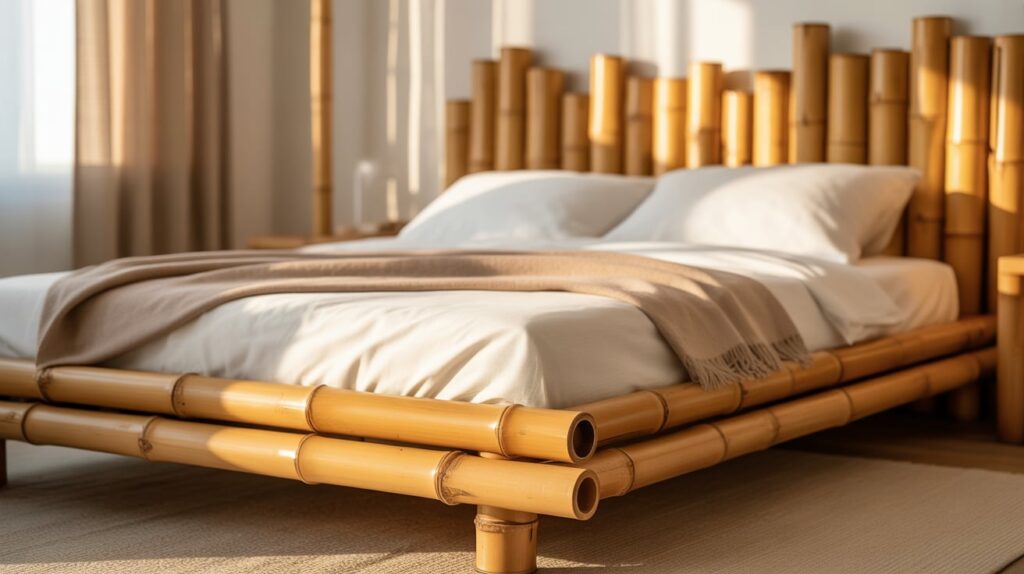
A bamboo bed uses smooth, strong bamboo poles or panels to form the frame. Bamboo is light, steady, and works well in rooms with natural colors. The frame stays firm when built correctly and supports most mattress types.
Bamboo beds fit small and medium rooms because their clean lines avoid crowding. Care is easy with occasional dusting. Many people pick bamboo for its simple look, steady support, and the light feel it brings to the room.
52. Brass Bed
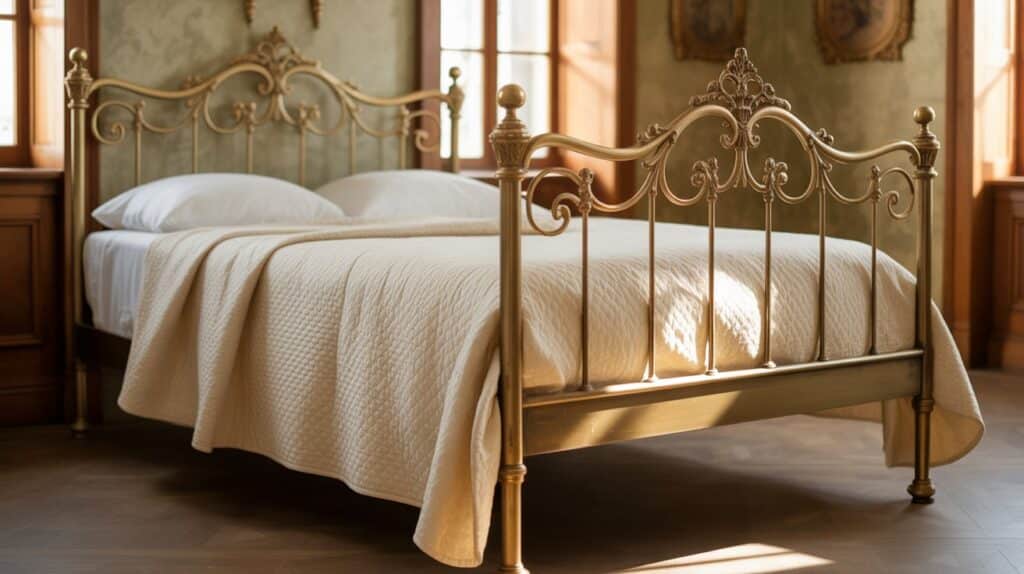
A brass bed uses metal with a warm tone to form the headboard, footboard, and frame. The surface can be bright or muted, depending on the finish. Brass beds stay firm and work with many mattress types.
They fit medium and large rooms that allow the frame’s shape and shine to show. Brass resists wear and lasts with simple cleaning. Many people choose brass for a steady frame with a warm metallic look.
53. Hybrid Material Bed (Metal + Wood Frames)
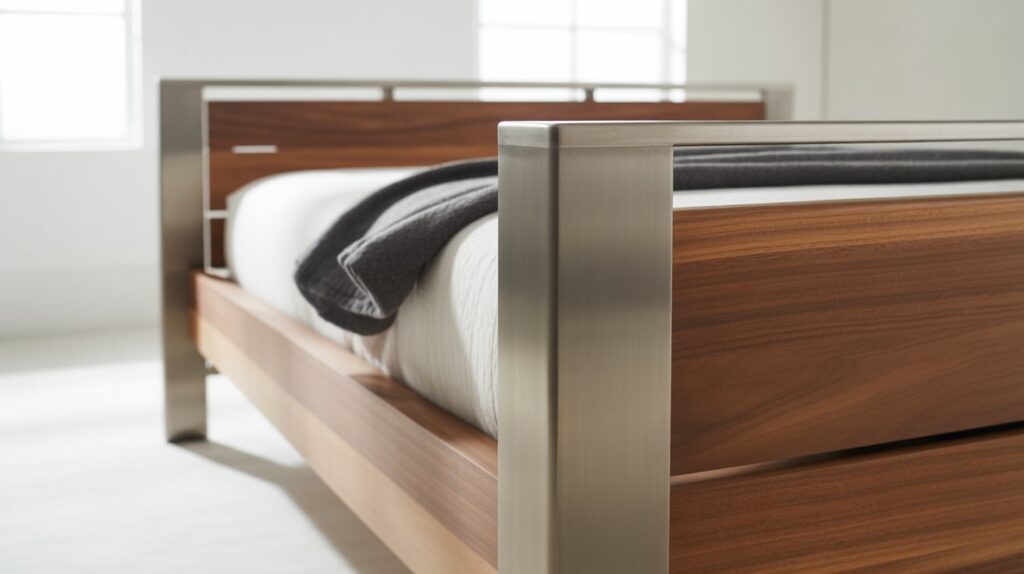
A hybrid material bed uses both metal and wood to form a balanced frame. Metal adds strength, while wood adds a warm surface. This blend works well in rooms that mix different furniture styles.
The frame stays steady and supports foam, hybrid, or spring mattresses. Many people choose hybrid frames for long-term strength without a heavy look. They fit small, medium, and large rooms because the combined materials keep the design flexible and simple to place.
Adjustable & Smart Beds
These beds offer added comfort through simple controls or built-in features. They help with pressure relief, support needs, and everyday resting habits for many sleepers.
54. Adjustable Bed
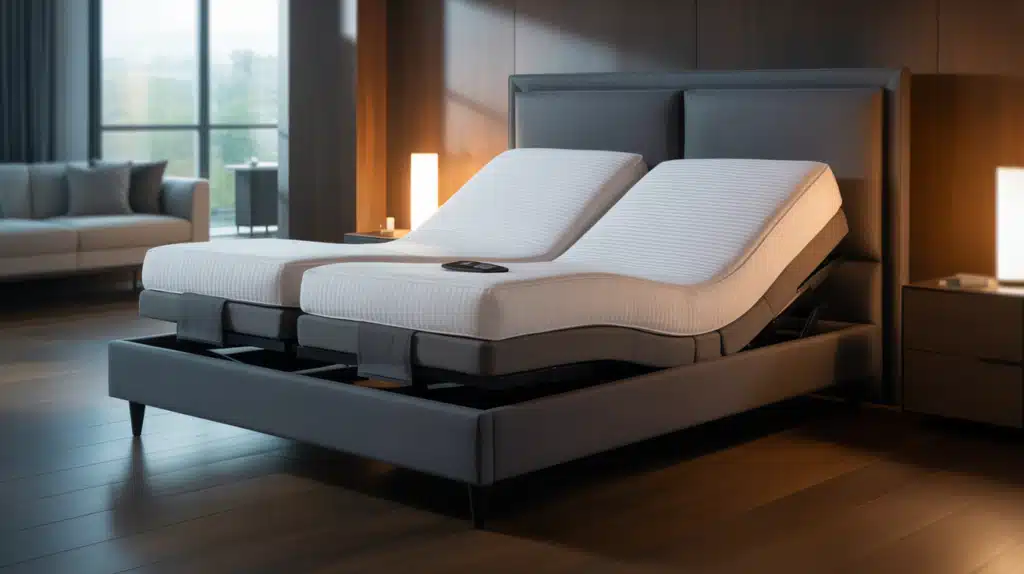
An adjustable bed lifts the head or foot sections with a button or remote. It helps people who need raised support for reading, resting, or easing soreness. The base moves smoothly and stays firm once set.
Many adjustable frames work with foam or hybrid mattresses that bend easily. These beds fit well in rooms where comfort needs may change over time. They are helpful for sleepers who want calm support without switching positions through the night.
55. Smart Bed

A smart bed includes built-in features such as gentle movement, sleep tracking, or simple control settings. These features help you adjust comfort levels without effort. The bed may sense pressure and shift slightly to support your body during the night.
Many smart beds work with apps that allow easy changes. They fit modern rooms that use connected devices for daily tasks. Smart beds offer steady comfort and help you understand how your sleep patterns change.
56. Hospital Bed

A hospital bed adjusts height, head angle, and leg angle to support medical or recovery needs. The frame is strong and built for frequent movement. Side rails help with safety, and wheels allow simple repositioning.
Hospital beds fit homes where someone needs steady support during healing or daily care. The controls help caregivers shift the bed easily. These beds provide firm, safe resting surfaces that help with comfort during long rest periods or medical routines.
57. Zero Gravity Bed
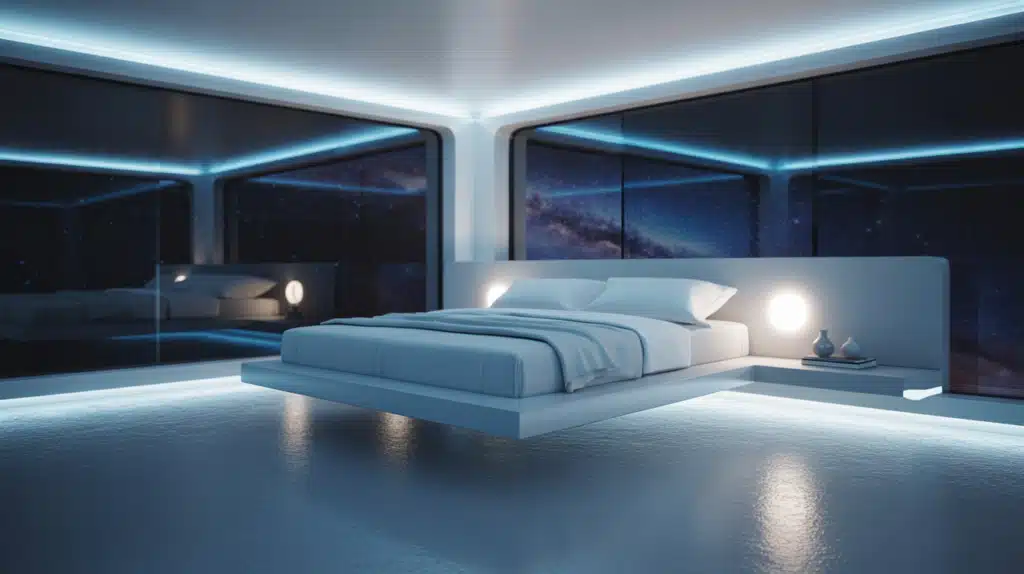
A zero-gravity bed raises the head and legs to ease pressure on the lower back. This position helps many sleepers relax and breathe comfortably. The base uses smooth controls that adjust slowly to avoid strain.
It pairs well with foam or hybrid mattresses that bend easily. People often choose zero gravity beds for calmer rest when they need gentle support. These beds work well for sleepers who shift often and want a balanced resting angle.
58. Massage Bed

A massage bed includes built-in vibration or movement functions that help relax sore muscles. The settings are usually adjusted through a simple control panel. These beds help people who want gentle comfort after long days or regular activity.
They work well with foam or hybrid mattresses that absorb movement evenly. The frame must be firm to support the built-in parts. Massage beds fit many room layouts and help sleepers unwind before resting for the night.
59. Sleeping Pod
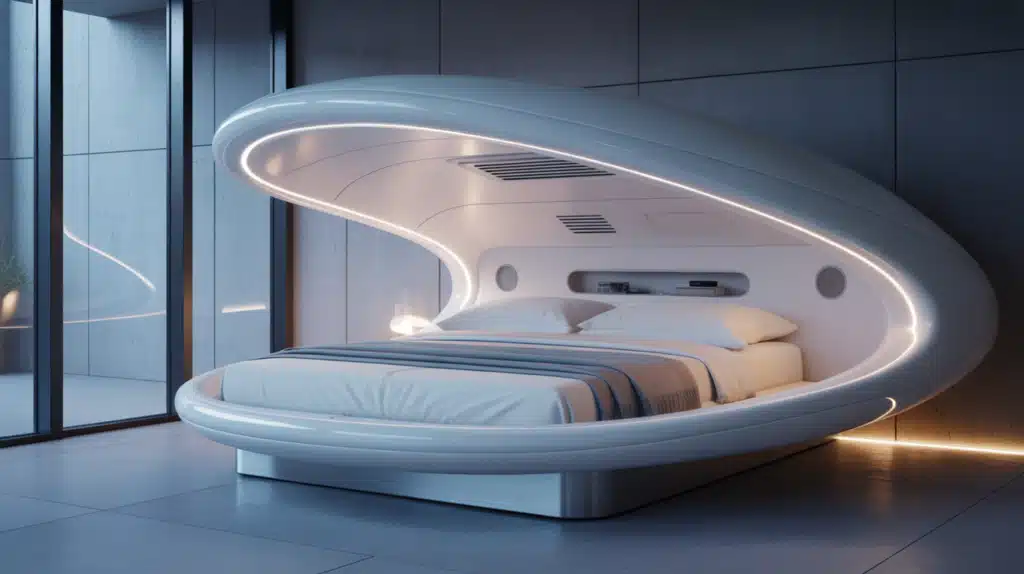
A sleeping pod is a self-contained resting space designed for privacy and simple comfort. Pods often include soft lighting, ventilation, and a firm mattress surface. They fit spaces like shared apartments, long-work environments, or rooms where quiet resting areas are needed.
The enclosed shape helps reduce surrounding noise and distraction. Pods offer a small, steady place to rest without taking much space. They support short or extended rest periods in a calm, contained setting.
Cultural & Traditional Beds
These bed types come from long-used designs in different regions. Each one reflects simple construction, daily habits, and practical needs shaped by local living styles.
60. Tatami Bed (Japanese)
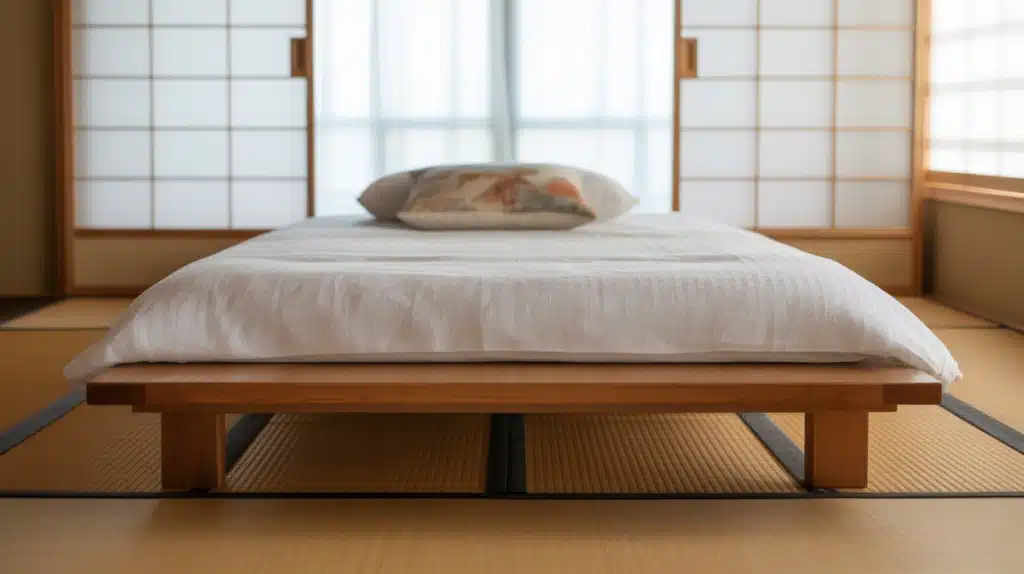
A tatami bed uses a low wooden frame or platform paired with firm tatami mats. The setup stays close to the floor and creates a steady, grounded resting area. Many homes use tatami for calm sleep and simple room layouts.
The firm surface supports proper alignment and helps small rooms feel open. Tatami beds also pair well with light bedding and allow free airflow below the frame. They work best for people who enjoy a firm resting surface.
61. Shikibuton Futon Mattress (Japanese)
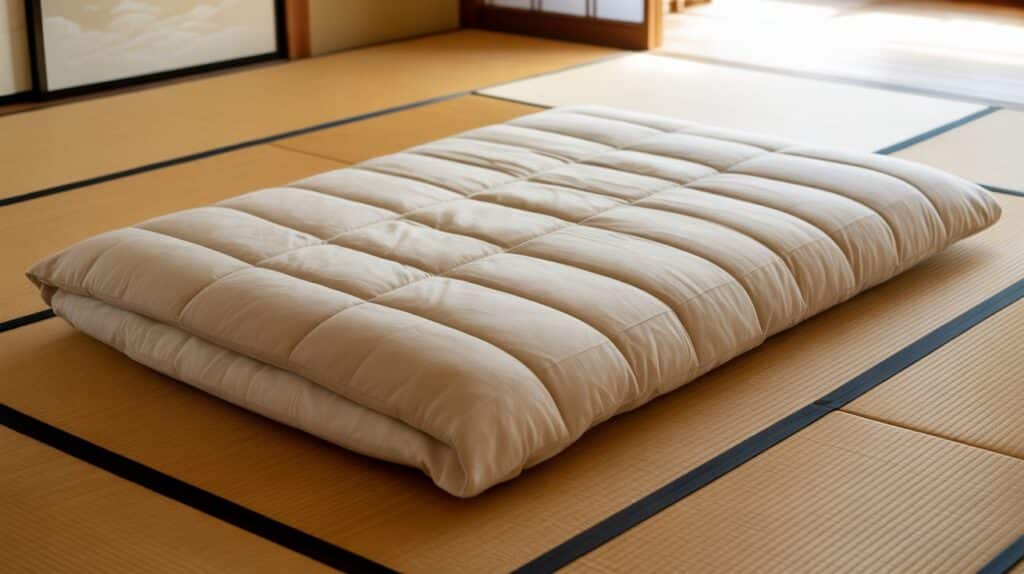
A shikibuton is a thin, foldable mattress placed directly on the floor or on tatami mats. It rolls up easily for storage, making it useful in small homes.
The firm surface helps with posture and supports simple room plans where spaces shift between sitting and sleeping. Many people choose shikibutons for easy care and natural materials. They fit well in minimal rooms and allow full use of the floor during the day.
62. Hammock Bed

A hammock bed uses a suspended fabric sling attached to strong mounts or frames. It gently moves with your body and offers light pressure support. Hammocks work in indoor or outdoor spaces that allow proper mounting.
They help small rooms stay open because they do not need a full frame. Many people use hammocks for short naps or in warm climates. The setup must be secure to hold weight safely without shifting during use.
63. Charpai / Manji Bed (Indian Subcontinent)
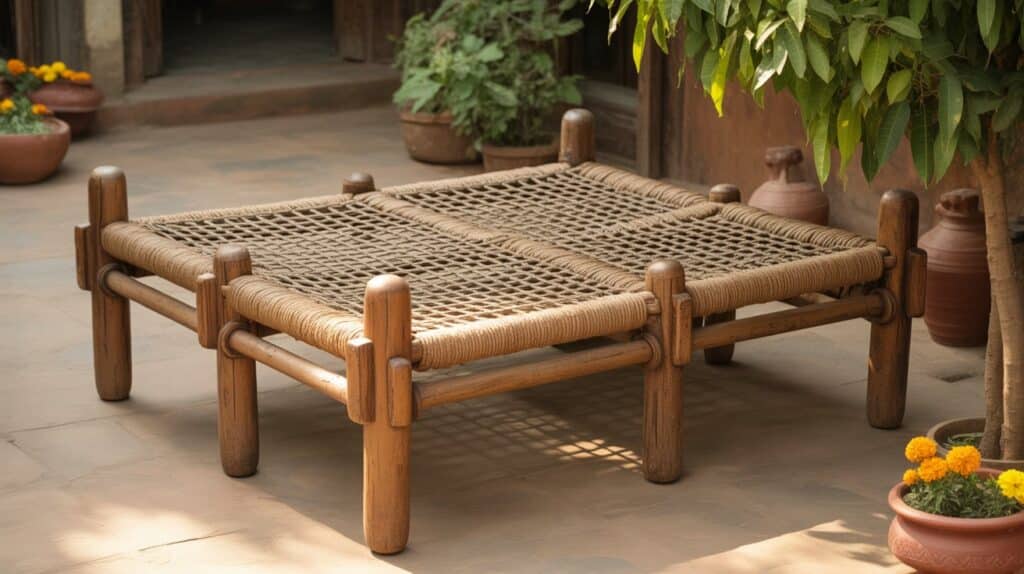
A charpai, also called a manji, uses a simple wooden frame with tightly woven rope or cord forming the surface. It is light, easy to move, and allows airflow from all sides.
Charpais help keep sleepers cool in warm climates and fit layouts where furniture needs to shift often. The woven surface offers firm support and stretches slightly with weight. This bed works well in small homes, outdoor areas, or rooms with open designs.
64. Divan Bed (UK)

A divan bed uses a fabric-covered base with optional drawers and a separate mattress placed on top. It fits small and medium rooms because the base stays low and steady.
Divans often include storage drawers that help keep rooms organized. The frame sits on small legs or gliders and stays firm under weight. This setup works well for people who want simple support without a bulky frame. It pairs easily with many mattress types.
65. Box Bed (European Traditional)
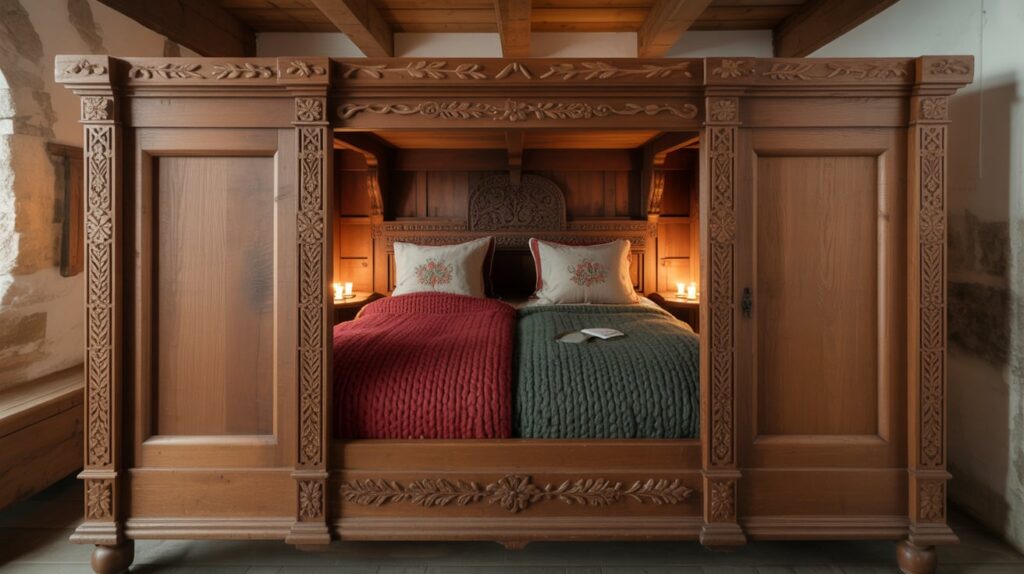
A box bed is an enclosed wooden frame with side panels and a partial front opening. It was used in older homes to keep warmth in and create privacy. The structure sits higher than simple frames and often includes storage below.
Though less common today, box beds bring strong support and a secure resting space. They work best in larger rooms due to their solid build. Some modern versions use lighter wood and open panels for better airflow.
66. Alcove Bed (French Traditional)

An alcove bed fits into a built-in wall recess or niche, forming a cozy sleeping area with wood or panel surrounds. It saves space while offering a calm resting place protected on three sides.
The design works well in older homes or modern builds that use custom wall features. Alcove beds keep rooms open by limiting the bed’s footprint. They support many mattress types and help create a steady resting space without crowding the room.
67. Cot Bed
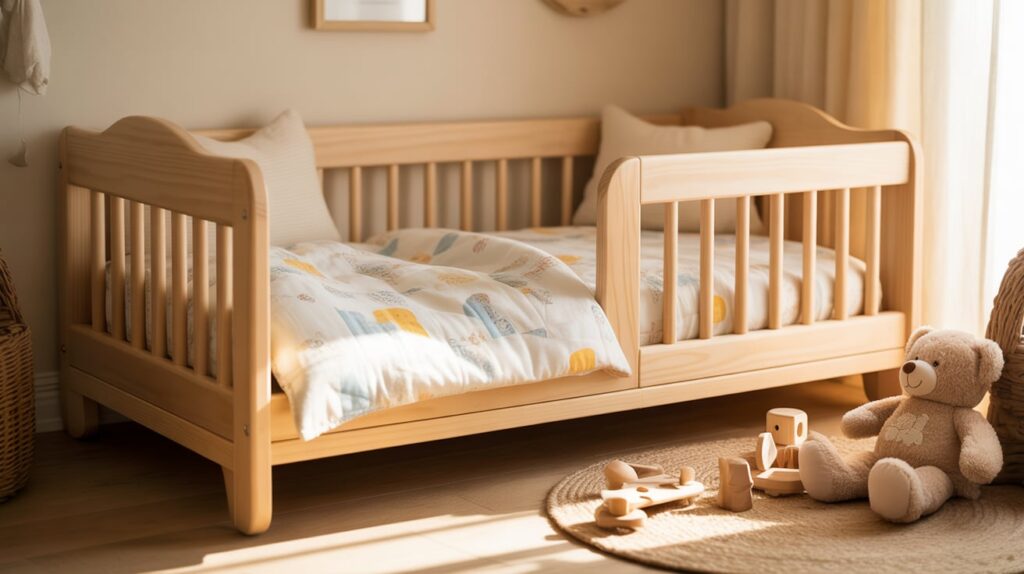
A cot bed is a small, foldable frame used for infants or toddlers. It includes firm railings for safety and a stable base for a supportive mattress. Cot beds often convert into toddler beds as children grow, making them practical for long-term use.
They move easily from room to room and work well in tight spaces. The simple build helps with cleaning and daily care. Cot beds offer steady, safe rest for young children.
Kids’ & Specialty Beds
These beds support growing children with safe frames, simple layouts, and playful shapes that help with rest, comfort, and daily routines at home.
68. Toddler Bed
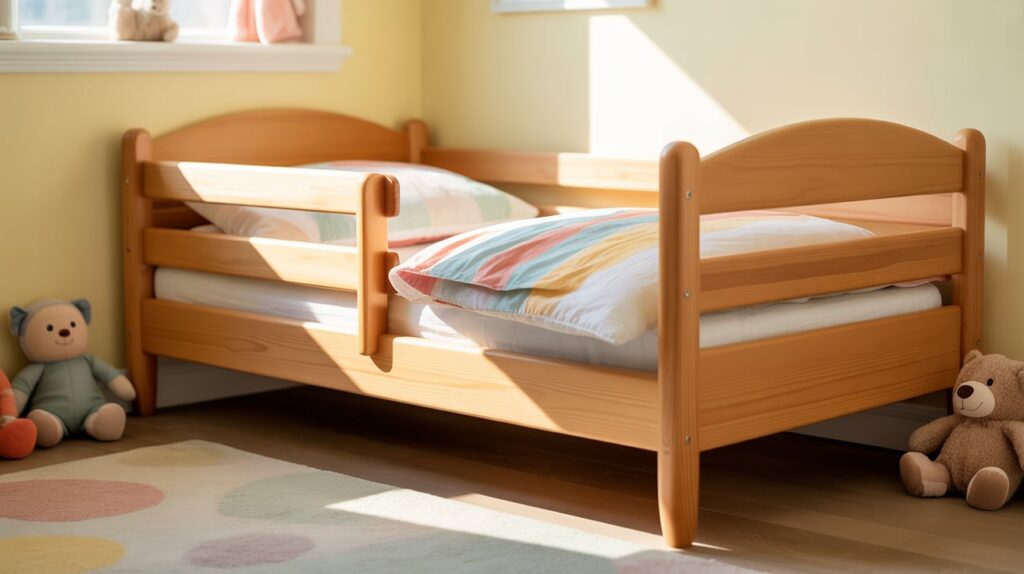
A toddler bed offers a safe step between a crib and a full-size frame. It sits low to help young children climb in and out easily. The frame includes railings that prevent rolling during sleep.
Toddler beds fit well in small rooms and allow open floor space for play. Many designs use sturdy wood or metal with smooth edges. They provide a steady, safe resting place during early childhood years and support small mattresses made for this stage.
69. Car Bed

A car bed uses a shaped frame designed to look like a vehicle. It helps children feel relaxed and engaged during bedtime. The low height supports safe climbing and reduces the chance of falls.
Car beds hold a standard toddler or twin mattress, depending on the model. They work well in play-focused rooms where creative shapes add interest. The frame stays firm and simple to clean. Many families choose car beds to help support easy bedtime routines.
70. Tent Bed
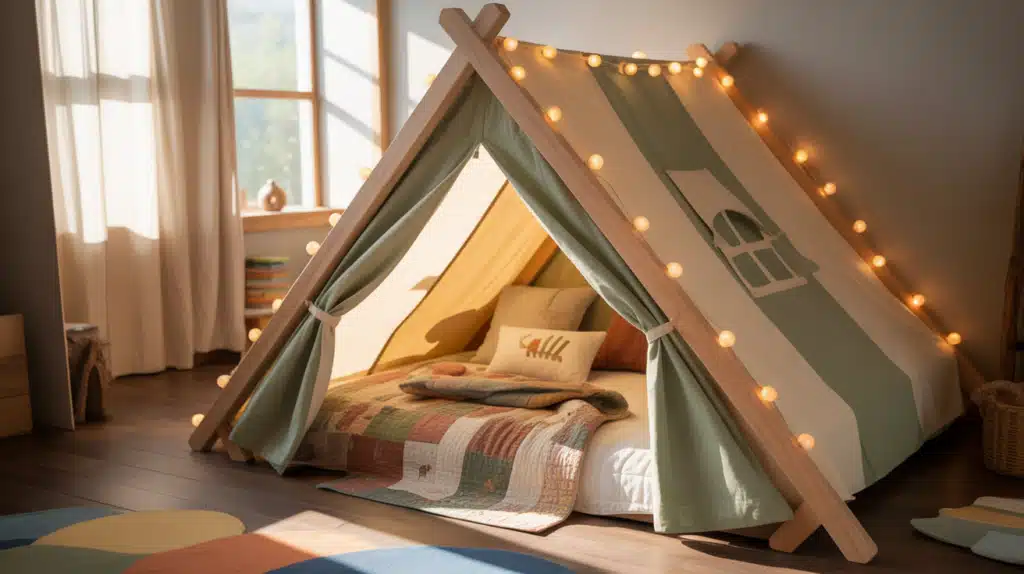
A tent bed includes a soft canopy or fabric cover that creates a sheltered space. It helps children rest in a calm, cozy area that feels protected. The frame sits low or mid-height, depending on the model, and works with standard toddler or twin mattresses.
Tent beds fit small and medium rooms because the soft cover takes minimal space. They encourage quiet rest while still allowing airflow. The frame stays steady, and the cover removes easily for cleaning.
71. Castle Bed
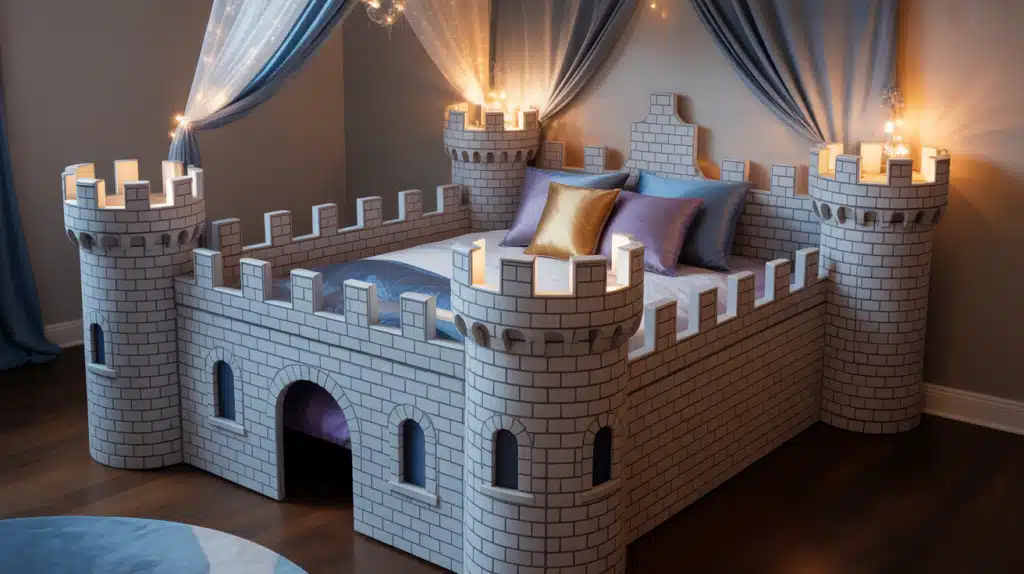
A castle bed uses shaped panels, small towers, or simple cutouts to form a playful resting space. It fits well in larger kids’ rooms that allow extra height or width. These beds may include ladders, slides, or built-in shelves, depending on the design.
The frame must stay firm to support daily movement. Castle beds make bedtime feel fun while still giving steady sleep support. They pair with twin mattresses and offer a clear resting area within a themed layout.
72. Montessori Floor Bed

A Montessori floor bed places the mattress low to the ground, allowing children to move freely and safely. The open design supports independence by letting children climb in and out without help. Floor beds fit well in small rooms and reduce fall risks.
Many versions use simple wood frames with smooth, rounded edges. The low height helps create an open, easy-to-use space. Families choose this option to support calm routines and simple, child-friendly movement during rest.
73. Treehouse Bed
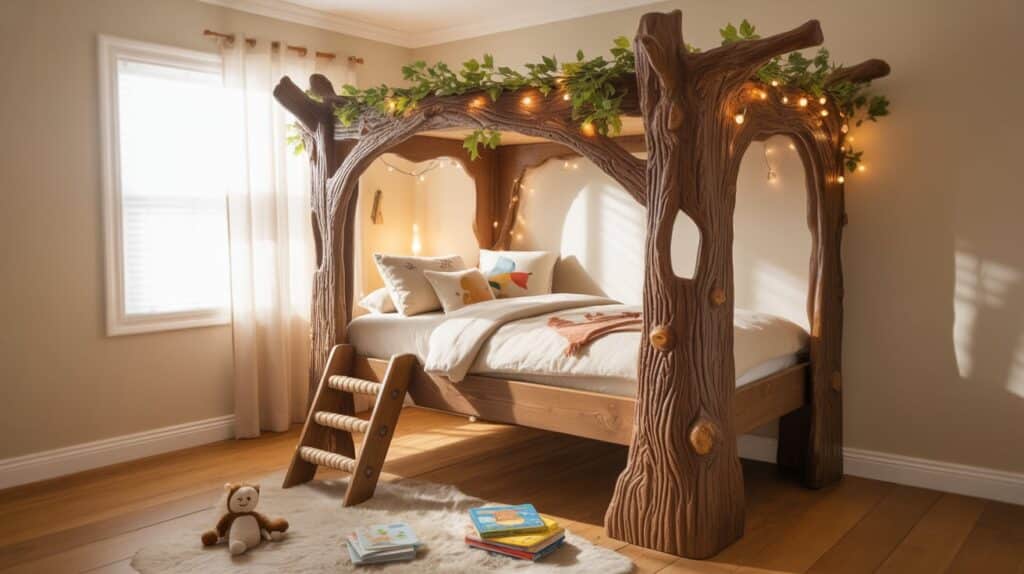
A treehouse bed is raised slightly and shaped with panels that look like a small hut or cabin. It gives children a playful resting area while keeping the sleeping surface steady. Some models include ladders or small windows for added interest.
Treehouse beds fit medium or large rooms, so the structure does not crowd the space. The frame supports a twin mattress and must stay firm under daily use. This setup brings play and rest together safely.
74. Crib
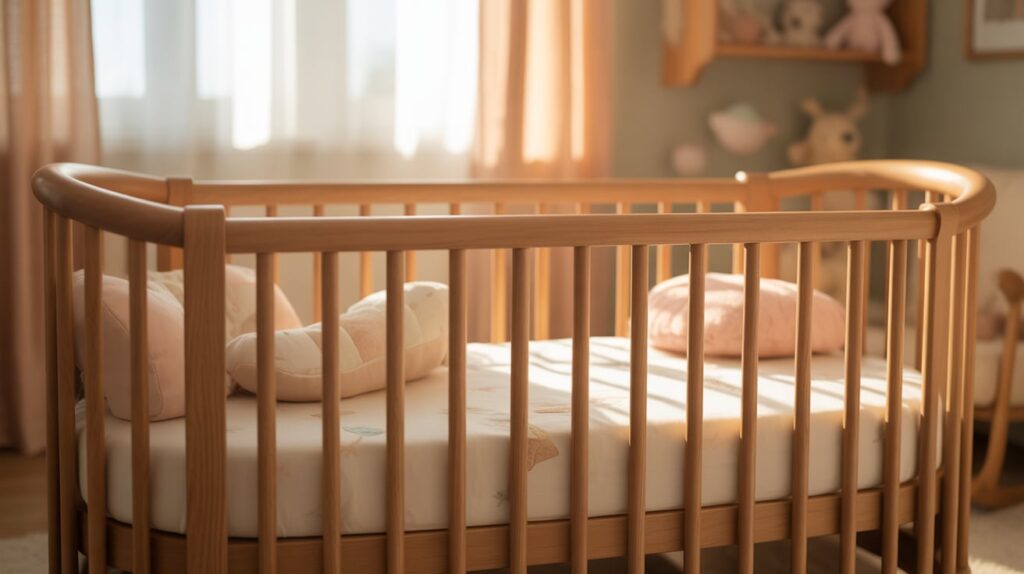
A crib is built for infants with high railings and a firm, snug mattress surface. The frame stays steady and prevents climbing or falling. Cribs allow adjustable mattress heights that lower as the child grows.
They fit well in small and medium rooms and pair with simple bedding for safety. Many designs use wood or metal and include smooth edges. Cribs support restful sleep in the earliest years and help caregivers maintain a safe environment.
75. Bassinet
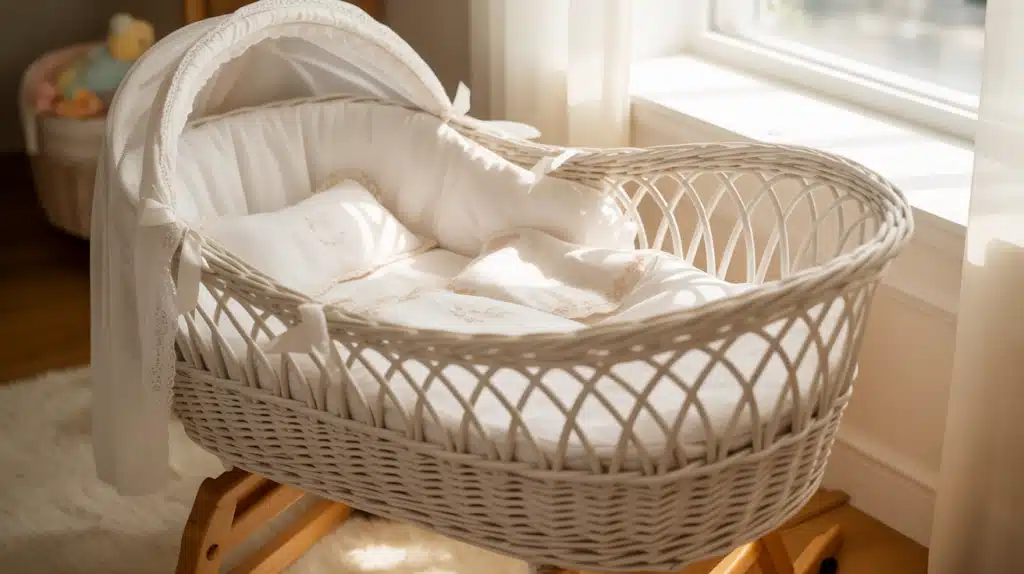
A bassinet is a small, raised sleeping unit for newborns. It stays close to a caregiver’s bed for easy access during the night. The lightweight frame moves between rooms and often has wheels or handles.
Bassinets include breathable sides and a firm, compact mattress. They fit very small spaces and support short-term use during early infancy. Many families choose a bassinet for its convenience and simple setup before moving to a crib as the child grows.
76. Youth Bed (Transitional Size for Older Kids)

A youth bed bridges the gap between a toddler bed and a full-size bed. It uses a slightly larger mattress while keeping a low, safe frame.
Youth beds fit well in small and medium rooms and help older children gain more sleep space without switching to a full bed immediately.
The frame stays steady and often includes simple railings. This option works well during the years when a child needs more room but still benefits from a compact frame.
Luxury, Designer & Niche Beds
This group includes unique beds shaped for special room layouts or bold designs. These frames stand out while still offering steady support.
77. Round Bed

A round bed uses a circular mattress and a matching frame. It fits large rooms where there is enough open space around the edges. The wide shape supports relaxed resting positions in any direction.
Round beds pair well with custom bedding and firm bases that prevent shifting. They work best in spacious layouts where the shape becomes a central feature.
People choose round beds for comfort, ample room, and a soft, open resting surface that encourages calm sleep.
Common Mistakes to Avoid When Choosing a Bed
These common errors can lead to discomfort, poor room flow, or safety issues. Avoid choosing a bed that does not fit your home well.
- Ignoring ceiling height with tall frames: Tall beds, such as canopy or four-post designs, need enough headspace. Low ceilings can make the room feel tight and reduce safe clearance.
- Buying a trundle that does not fit under the main bed: Some trundles require extra height or width. Always measure the space under the frame before purchasing to ensure smooth movement.
- Placing a heavy sleigh bed in a small room: Sleigh frames take more floor space than other styles. In tight rooms, they can block paths and limit furniture placement.
- Choosing a low platform for someone with limited mobility: Low beds can make it harder to sit or stand. Older adults or people with joint pain often need a higher frame for easier use.
- Forgetting to check mattress and frame compatibility: Some frames need specific mattress types or support systems. Make sure the base and mattress work well together for steady comfort.
- Overlooking needed walking space: A bed that is too large for the room can block doors, reduce movement, and make daily tasks harder.
- Not checking ladder safety on bunk or loft beds: Ladders and guard rails must be strong and properly placed to prevent falls, especially for young sleepers.
- Choosing storage beds without side clearance: Drawer units need enough open space to slide out. Tight layouts can prevent full access and reduce usefulness.
Maintenance & Durability Tips Based on the Bed Type
Keeping each bed in good shape helps it last longer and stay comfortable. Upholstered frames need regular vacuuming to remove dust and prevent marks from settling into the fabric.
Wood frames benefit from gentle wiping with a soft cloth and occasional polishing to keep the surface smooth and free from dryness.
Metal frames may squeak over time, so tightening loose joints and adding a light coat of safe lubricant can help reduce noise.
Beds with slats should be checked once in a while to make sure none are bending or shifting out of place, since worn slats can affect mattress support.
Murphy beds need steady hinge checks so the folding system works smoothly without strain. Adjustable beds rely on motors, so keeping the remote, cords, and moving sections clean and unobstructed helps them function safely and consistently.
Conclusion
So now you have a clear view of how bed sizes, frames, storage options, and special designs all fit different needs.
The main idea is simple: the right frame should fit your room, support your body, and make daily life easier, not harder.
When you match size, height, storage, and material to your space, your bed stops being guesswork and becomes a solid, long-term choice.
If you’re ready to keep going, I’d love for you to read more of my bedroom and furniture posts and see how they connect back to these types of beds. Go ahead and check out my other blogs next.


